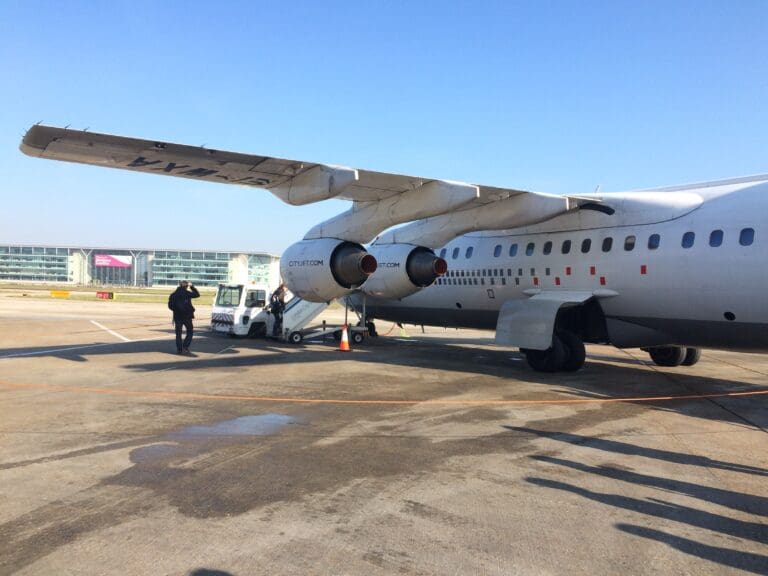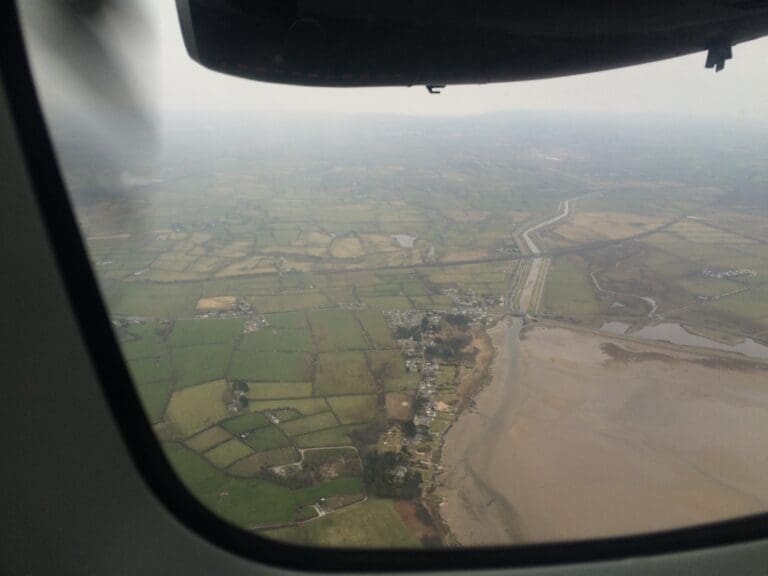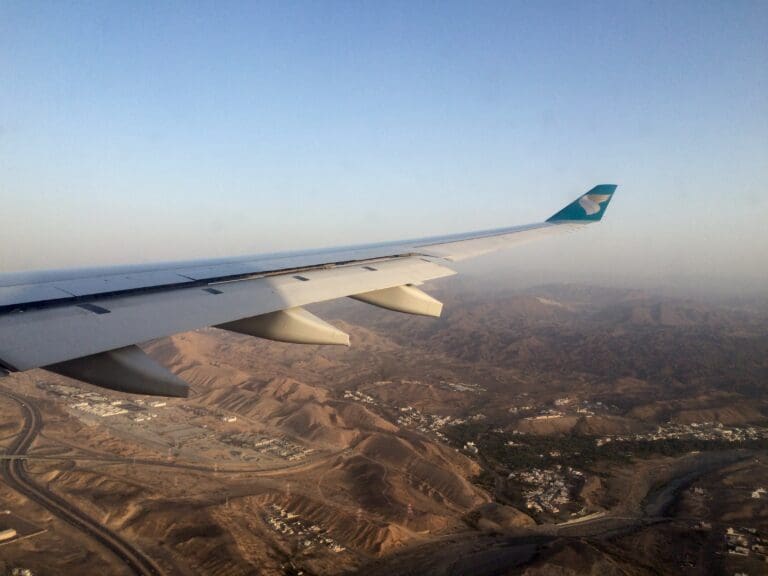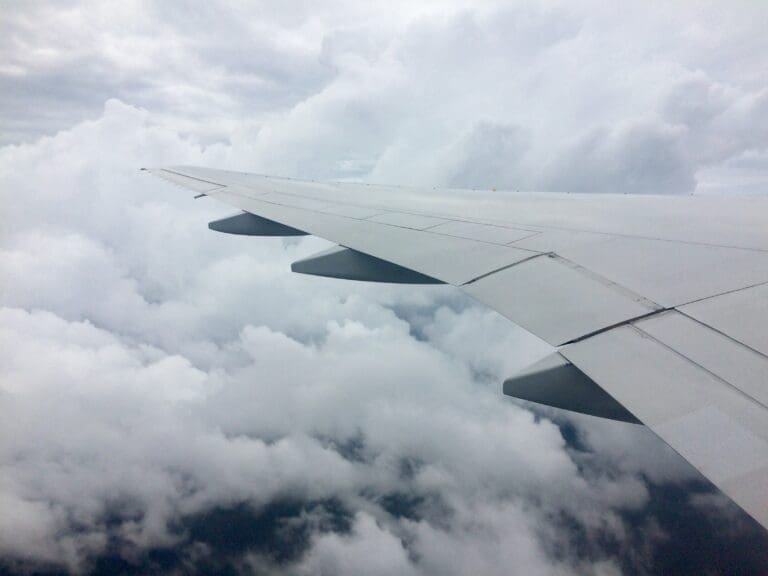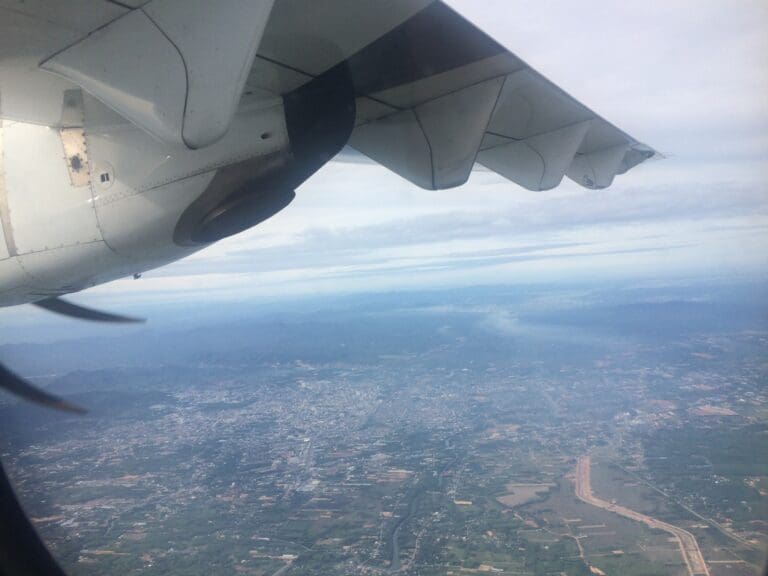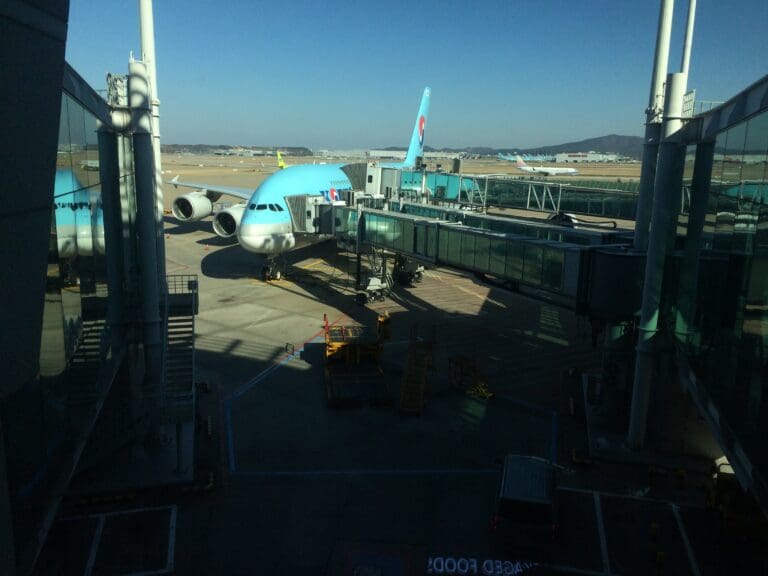Sampling Korea’s Largest LCC: Seoul Gimpo to Jeju with Jeju Air
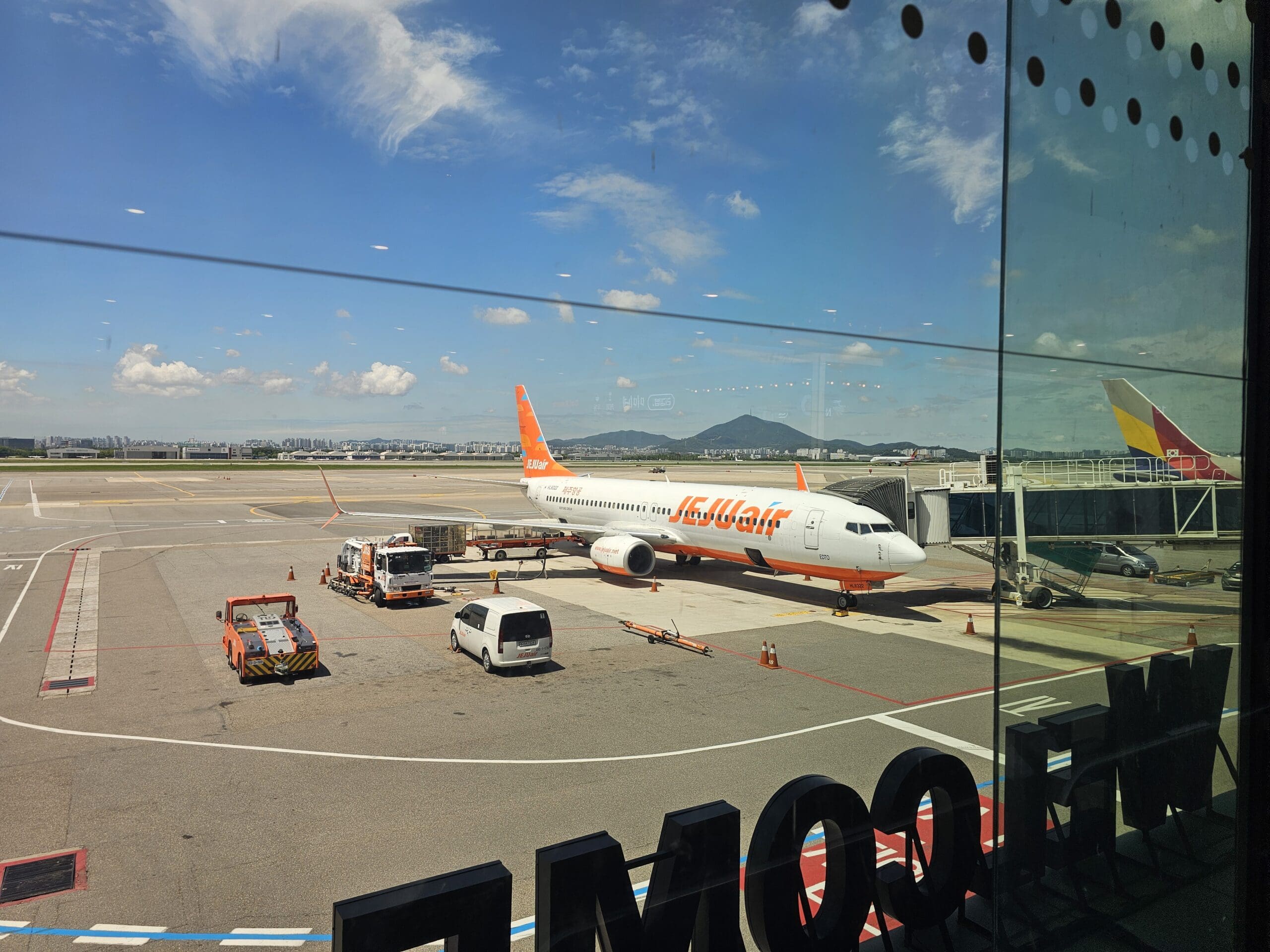
I took this flight in July 2024 before the sad events that occurred at Muan Airport – my condolences are with all those impacted by this terrible accident
About Jeju Air
Judging by its name, you may assume that the Korean low-cost carrier Jeju Air specialises in connecting the Korean Peninsula with its largest island, Jeju. Indeed, whilst Jeju Air does fly a near endless slew of flights every day between Jeju and Busan, Cheongju, Daegu, Gwangju, Muan and Seoul Gimpo, the airline’s route network extends well beyond the confines of Korea. In fact, having flown 12.3 million passengers in 2023 and serving 47 destinations across 15 countries with a fleet of 41 Boeing 737 jets (as of July 2024), Jeju Air is Korea’s third largest airline.
For a long time, the Korean airline industry was all but closed off to new entrants. Once dominated by Korean Air, it took years of lobbying for the government to permit the establishment of a second carrier, Asiana Airlines, in 1988. However, this did not open the floodgates, and a combination of regulatory hurdles and opposition from Korea’s two carriers meant that nearly two decades passed before a third airline commenced operations. By the early 2000s, a host of low-cost carriers across the world had demonstrated their ability to turn a significant profit, and within the Korean business arena, a growing number of parties wanted a slice of the action. Indeed, with an increasingly high number of Koreans holidaying abroad, there was a clear demand for low-cost airlines to sweep in and undercut their full-service competitors on routes to the likes of Japan and Southeast Asia. Fortunately, the loosening of restrictions made it slightly more viable to start an airline, and as a result, Jeju Air was established in January 2005, becoming Korea’s third carrier. This was a venture between the Aekyung Group, a lesser-known conglomerate specialising in chemical products, and the Jeju Provisional Government.
Over a year after being established, in April 2006, Jeju Air’s first aircraft, a brand new Dash 8 Q400, touched down on Korean soil and was pressed into service on domestic routes in June of that year. Throughout the remainder of the year, an additional four Dash 8 Q400s were delivered to the carrier, and for the next couple of years, the airline operated flights across Korea, proving its capabilities before being permitted to operate flights overseas. In 2008, Jeju Air’s first two Boeing 737-800 were delivered, and the airline performed a series of international charter flights before commencing their first scheduled international services in 2009, establishing routes from Seoul Incheon to Bangkok, Kitakyushu and Osaka Kansai, and between Cheongju and Bangkok. Since then, the airline’s list of destinations has continued to gro,w and the carrier connects Korea with China, Guam, Hong Kong, Japan, Laos, Macau, Malaysia, Mongolia, the Northern Mariana Islands, the Philippines, Singapore, Taiwan, Thailand and Vietnam. At one stage, Jeju Air even operated fifth freedom flights from Tokyo Narita to the likes of Guam and Hong Kong! Meanwhile, in 2016, Jeju Air became a founding member of the Value Alliance, consisting of low-cost carriers from across the Asia Pacific region.
Supporting their growing operation, Jeju Air’s fleet continued to grow and was consolidated into an all-Boeing 737 fleet, with their final Dash 8 Q400s bowing out from service in 2010. In 2018, Jeju Air announced a massive order for up to fifty Boeing 737 MAX 8 jets, the first of which was delivered to the carrier in late 2023. Meanwhile, in 2022, Jeju Air added their first converted Boeing 737-800 Freighter and, at the time of my flight, operated two of these aircraft from Incheon Airport to Hanoi, Tokyo Narita and Yantai.
So how did I end up flying with Jeju Air?
My reasons for flying with Jeju Air were simple. I needed to get to Jeju! Offering the cheapest tickets at a time that suited my schedule, I had no reason not to fly with the airline from Seoul to Jeju. This would be my seventh time flying with Jeju Air, having flown with the carrier on short domestic hops, alongside a slightly longer midnight ride from Daegu to Beijing back in August 2017. To be honest, my experiences hadn’t been unilaterally positive. Whilst all had been fine once onboard, with a polite and friendly crew and acceptably comfortable cabins (for a low-cost carrier), most of my flights had arrived behind schedule, sometimes significantly so. Nevertheless, I was still willing to fly the carrier, and on that particular day, not being on an overly tight schedule, I wasn’t willing to pay the significant premium required to fly with anyone else.
Booking
When flying domestically in Korea, I always find it best to book directly with the operating carrier. Not only do airlines almost always offer the cheapest tickets on such routes, but, by doing so, if you end up needing to cancel your ticket, then you can make use of Korean carriers’ generous conditions that enable you to do so for nothing more than a nominal fee.
Upon landing on Jeju Air’s modern website, I was presented with a scrolling banner that advertised the various perks of the airline’s Refresh Point frequent flyer programme. Wasting no time, I soon hit the search engin,e and once I had entered all the required information, I was presented with a long list of Jeju Air’s flights from Seoul Gimpo to Jeju on my chosen departure day. Being a key route for the airline, I was presented with an impressive total of 21 direct flights to Jeju that day, with these scheduled to depart Seoul Gimpo at regular intervals as low as every ten minutes from 0615 to 2030.
Each flight came with three three fare options – Fly, Flybag and Flex, however, booking just a few days in advance, the cheapest ‘Fly’ fares were unavailable for most services, and thus whilst not intending to take a bag, I was left with no choice other than to book the slightly more expensive ‘Flybag’ fare. For those looking to bring hold luggage, one downside of Jeju Air is that the carrier does not permit those on their cheapest fares to bring any hold luggage with them without additional payment. Indeed, whilst this falls into line with what you would expect from a low-cost carrier, it certainly isn’t the norm in the Korean low-cost aviation scene. At Korea’s other low-cost carriers, even those who are flying on the cheapest domestic tickets are afforded the luxury of bringing at least 15kg of hold luggage with them without any additional payment.
Once I had selected my flight, I was presented with a seat map where I could pay to pre-reserve a seat for between 2,000 won (£1.13) and 11,000 won (£6.29). Those who decide against this can also pick any vacant seat on the aircraft during the online check-in process. In the end, wanting to guarantee myself a window seat I decided to select one in the rear half of the cabin, which brought my total fare up by 3,000 won (£1.72) to a still very reasonable 29,900 won (£17.11). Once done, I was taken to the payment page and without issue, I made payment quickly and easily before instantly receiving my ticket via email.
Online check-in for Jeju Air’s services commences 24 hours before departure, and, being a domestic flight, I did not envisage any issues with this. Indeed, as I had hoped, this was a quick and easy process that required me to do little other than reconfirm my details before I received my boarding pass.
The Journey
As someone who loves a good bargain, when heading down to Jeju, I almost always seem to end up rocketing off in the first wave of departures. Regardless of airline, tickets for the first few flights of the day are usually the cheapest, and statistically, you are less likely to be affected by a delay than if you end up taking a later flight. This does, however, necessitate waking up at the crack of dawn and catching one of the first trains of the day to Gimpo Airport. However, I should also note that if you’re departing on the very first few flights of the day to Jeju between 0600 and 0645, and don’t fancy spending a good hour onboard a city bus as it winds its way through almost every neighbourhood on the west side of Seoul, then you will probably have to take a taxi to the airport.
However, that day, my midday departure meant that I was able to shake things up a little, and for once, I would not have to set my alarm for 0445 as had become my routine when heading south. Waking up at the much more civilised hour of 0830, upon opening the curtains of the officetel, I was greeted by the delightful sight of sunny skies. Being in the throngs of the horrifically humid Korean summer, I had become far more accustomed to mist, grey skies and heavy rain showers, and this was the first time I had seen the sun shine down on Seoul for about two weeks! This made me a little regretful that I had booked the Jeju Air experience for this day, especially when I checked the weather forecast and discovered that Jeju was set to be lashed by apocalyptic rain showers that day. Once wide awake, I darted into the shower, changed into a fresh set of clothes and gathered up everything I would need for the day before heading out onto the busy streets of Seoul.
As is usually the case when heading to Gimpo Airport, I saw absolutely no point in reaching this by any means other than Korail’s Airport Express service. Connecting Seoul Station with Incheon Airport Terminal 2, the all-stop service makes twelve intermediate stops in Seoul, Incheon and the areas between the two, including both Gongdeok and Gimpo Airport. Taking just eighteen minutes to travel the thirteen or so kilometres between Gongdeok and Gimpo, if starting from near Gongdeok Station, this is usually quicker than taking a taxi between the two and is far cheaper, with the ride costing just 1,600 won (£0.92) when paid for by a T-Money card. After about ten minutes of trundling through the Korean summer heat, I arrived in the subterranean world of Gongdeok Station. Connected by four lines and serving what is a relatively important neighbourhood with plenty of skyscrapers and company headquarters dotted around, Gongdeok Station is large and always seems to be busy, with crowds of passengers scurrying about here, there and everywhere. Not being in any pressing rush, I decided to stop by at the local branch of Paris Baguette for a coffee and a savoury bun for breakfast, taking this away and munching as I weaved in and out of the crowds.
Eventually, I made it to the westbound Airport Express platform and a few minutes later, a Hyundai Rotem electrical multiple unit came hurtling into the platform. Being a weekday and with perhaps many people being hard at work, this was pleasantly quiet, and I was able to grab a seat for the dart westwards. Following stops at Hongdae and Digital Media City, we flew across the Han River before heading back underground. With all going to plan, around eighteen minutes after boarding the train in Gongdeok, I disembarked at Gimpo Airport Station. It is worth noting that whilst this station is conveniently located between the detached international and domestic terminals, and joined to both via a series of underground passageways, when flying domestically it does take around five minutes to get from platform level to the check-in hall, and a little longer to reach that of the international terminal. Thus, whilst Gimpo Airport is designed to be somewhere that can be passed through in a rush, I would still caution passengers against cutting things too fine.
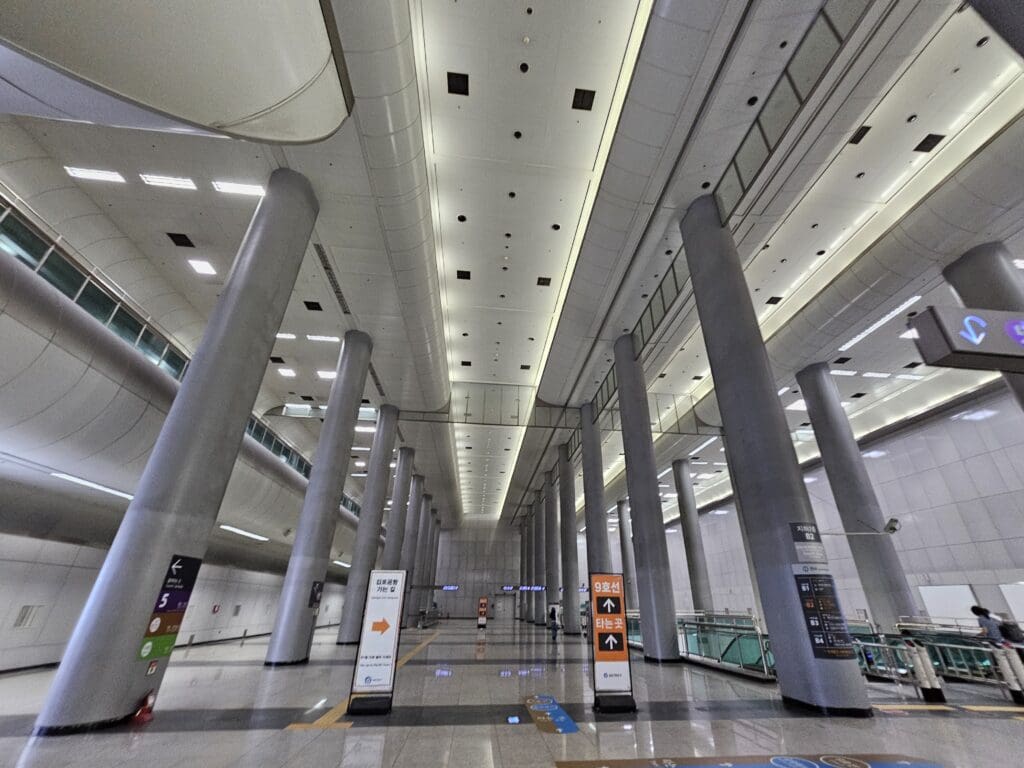
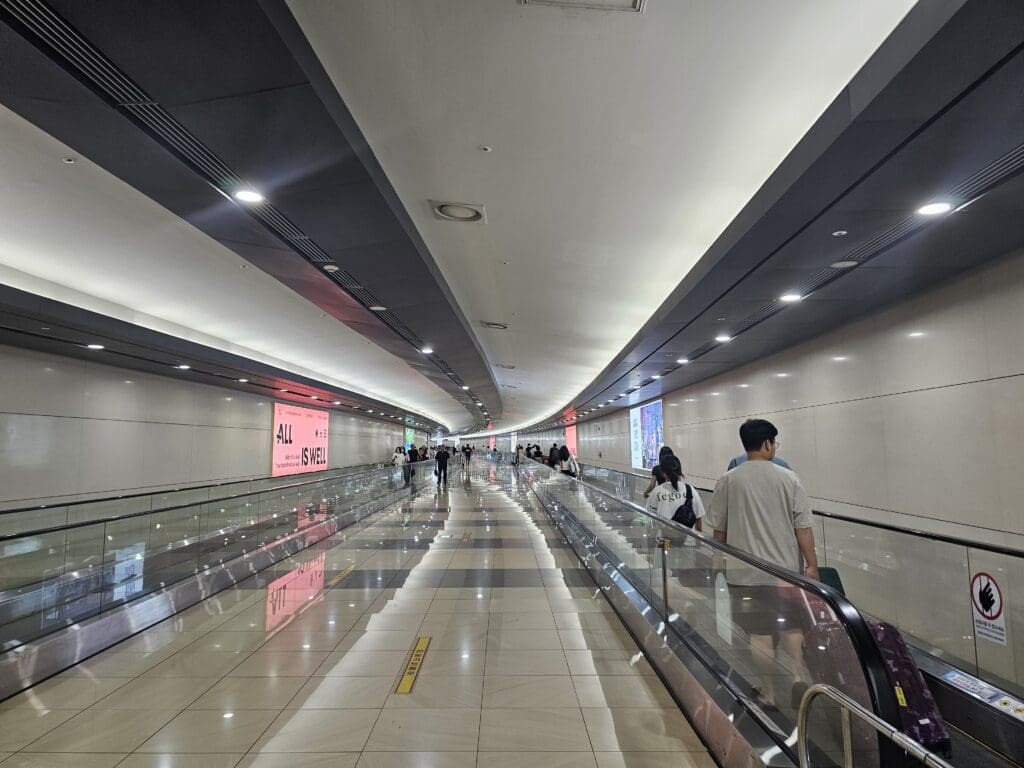
Once I had tapped out, I turned left and made my way along the series of moving walkways before heading up a set of escalators and arriving at the terminal’s arrivals level. From there, I continued heading upward and soon reached the check-in hall on the terminal’s first floor. This is spacious, modern, bright and airy, and like the rest of the terminal, this has undergone a series of renovation work that concluded in 2018. There, each airline enjoys its own check-in area, and whilst I had a mobile boarding pass and lacked anything to drop off, I ended up inadvertently wandering past Jeju Air’s check-in area. This was well branded with plenty of signage and, despite a general lack of passengers, featured plenty of staff on duty ready and raring to assist passengers. Meanwhile, those departing on any airline from the domestic terminal can use the Korean Airport Corporation-owned self-check-in machines, of which there are plenty spread out across the check-in hall.
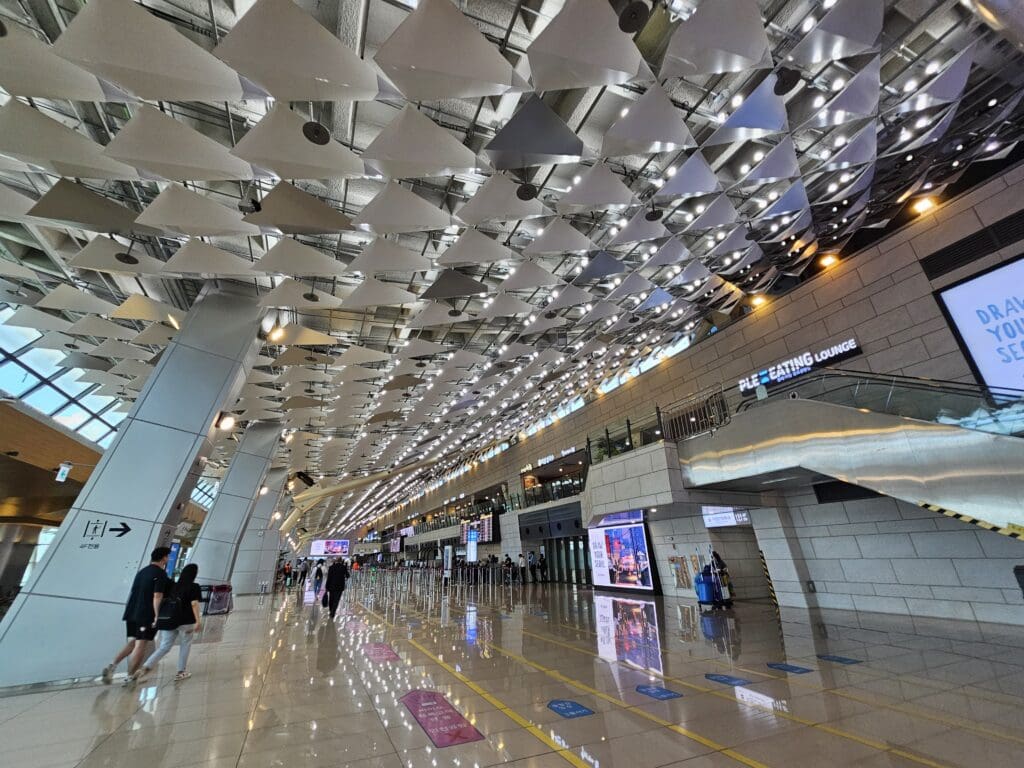
Arriving at the check-in hall with about two hours to go until my flight, I had plenty of time on my hands, and I thus decided to wander around and grab my second coffee of the day. When it comes to facilities, the landside portion of the domestic terminal features a delightfully impressive array of restaurants and cafés, along with a few shops. Specifically, this is home to twenty restaurants that range from fast food outlets to more formal sit-down eateries, eleven cafés, four shops and a pharmacy. However, perhaps the highlight of this for an aviation enthusiast is the open-air observation deck, which is just one of three in Korea (if you include that of Incheon Airport, which sits on the airport’s perimeter). Of course, being an enthusiast with time on my hands, I could hardly pass on the opportunity to visit thi,s and once I had my coffee in hand, I journeyed up to the terminal’s top floor, passing through the food court before reaching the observation deck.
Offering good views out over the eastern ends of Gimpo Airport’s two runways and of several of the domestic terminal’s stands, this is the only part of the landside portion of the terminal that provides airside views and is a great place to kill time. That morning, the usual slew of aircraft from every single Korean passenger airline bar Aero K and Air Premia could be seen. Aside from these, the south side of the airfield is home to an eclectic selection of aircraft, some of which, such as the Lake LA-250 Renegade, you wouldn’t perhaps expect to see at a major international airport! At that time, several Cessnas undertaking aerial survey duties, along with a sleek Embraer Praetor used for calibration, could be seen basking in the sunshine amongst many other aircraft. Additionally, not too long after my arrival, two Korean National Police Korea Aerospace Industries KUH-1 Surion helicopters came steaming in before settling down next to the police hangar on the other side of the runways.
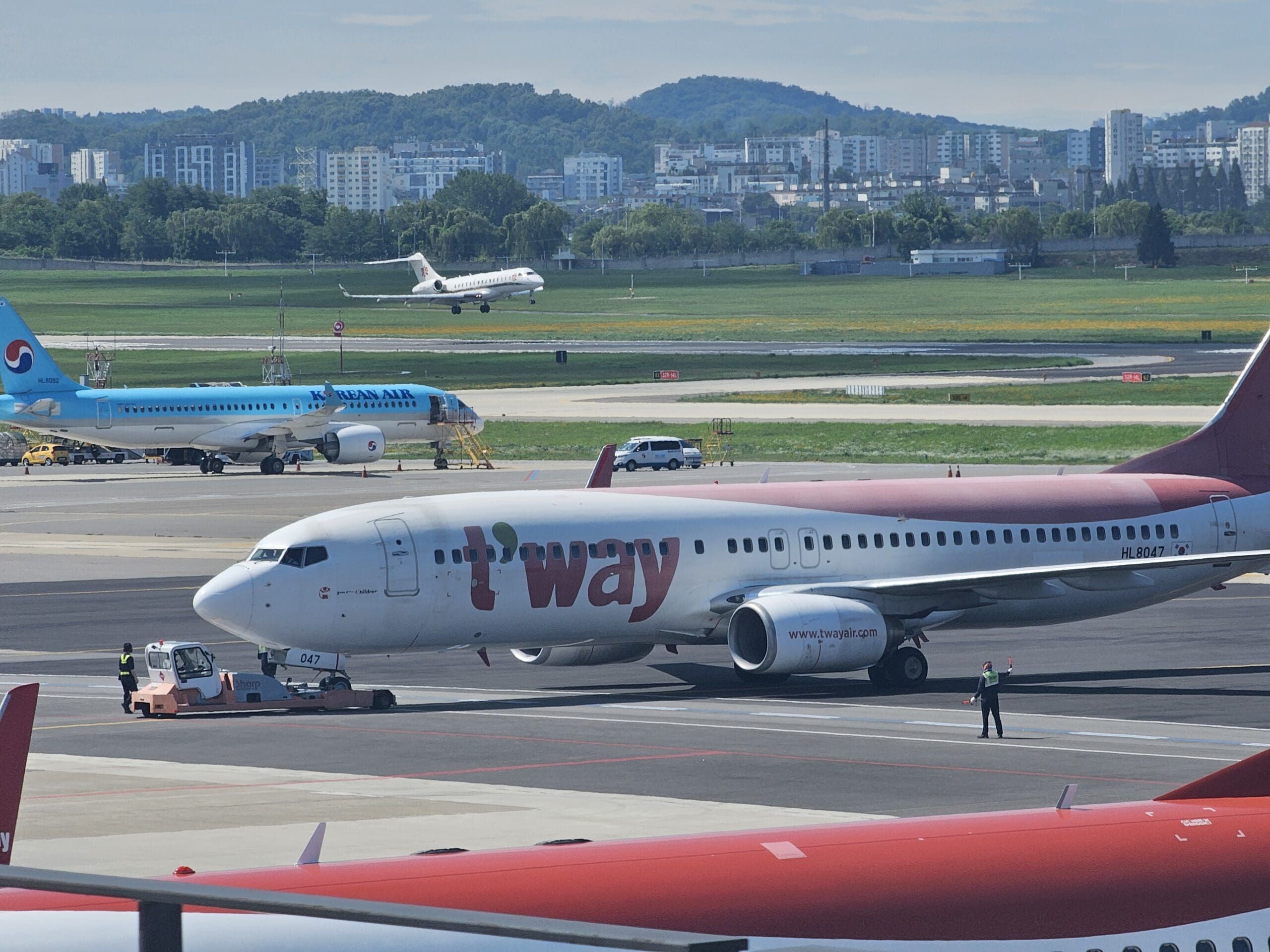
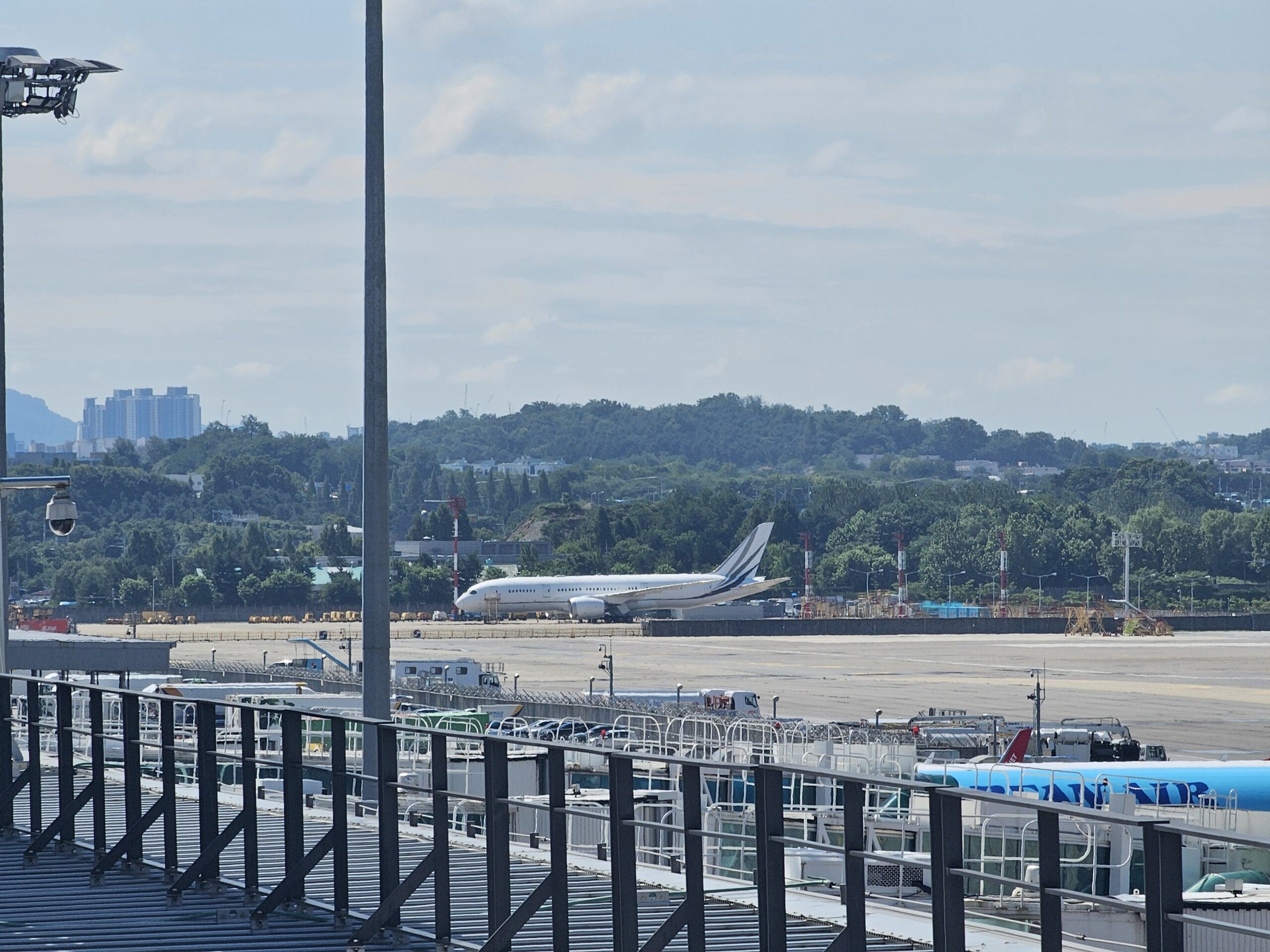
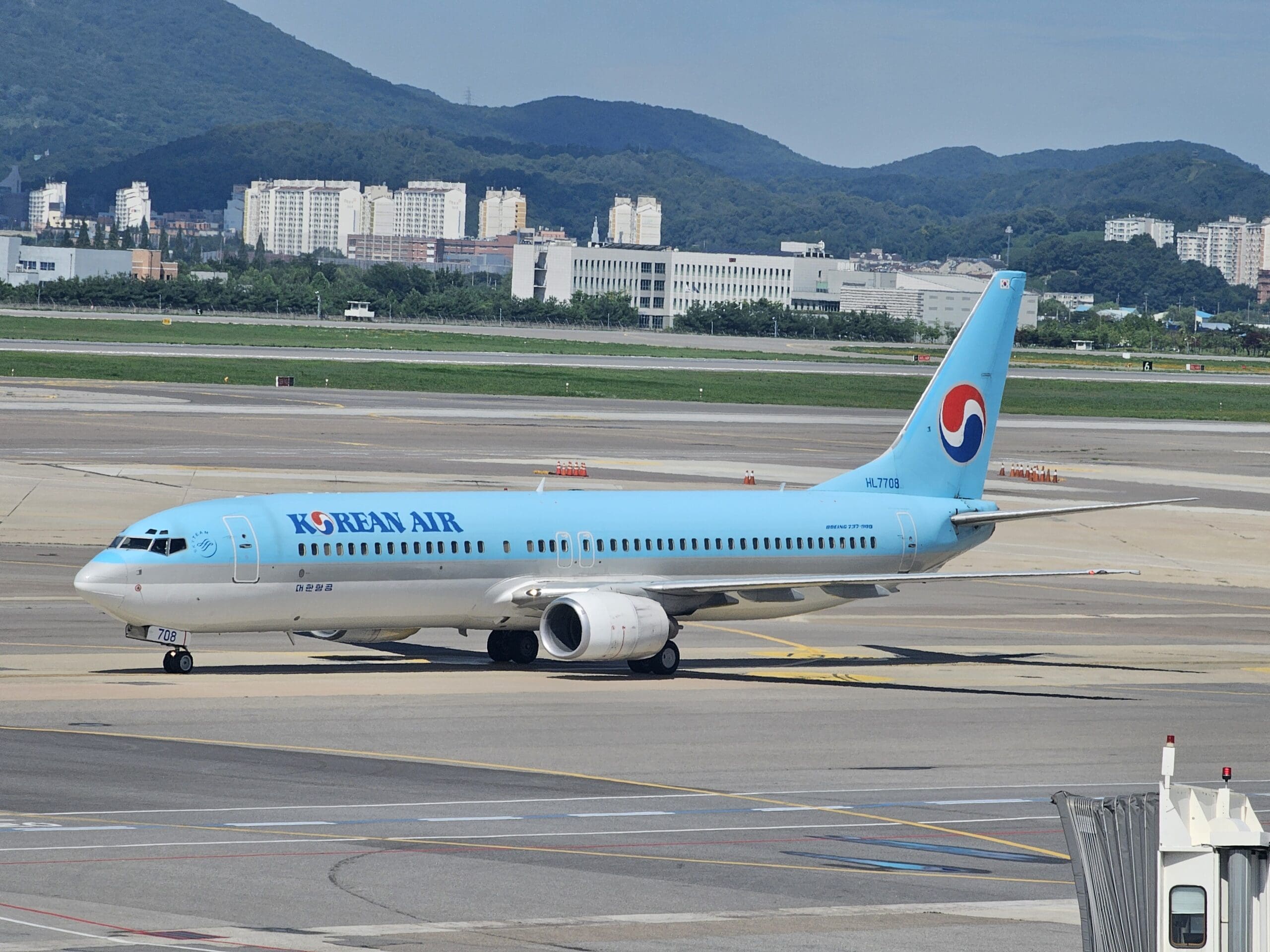
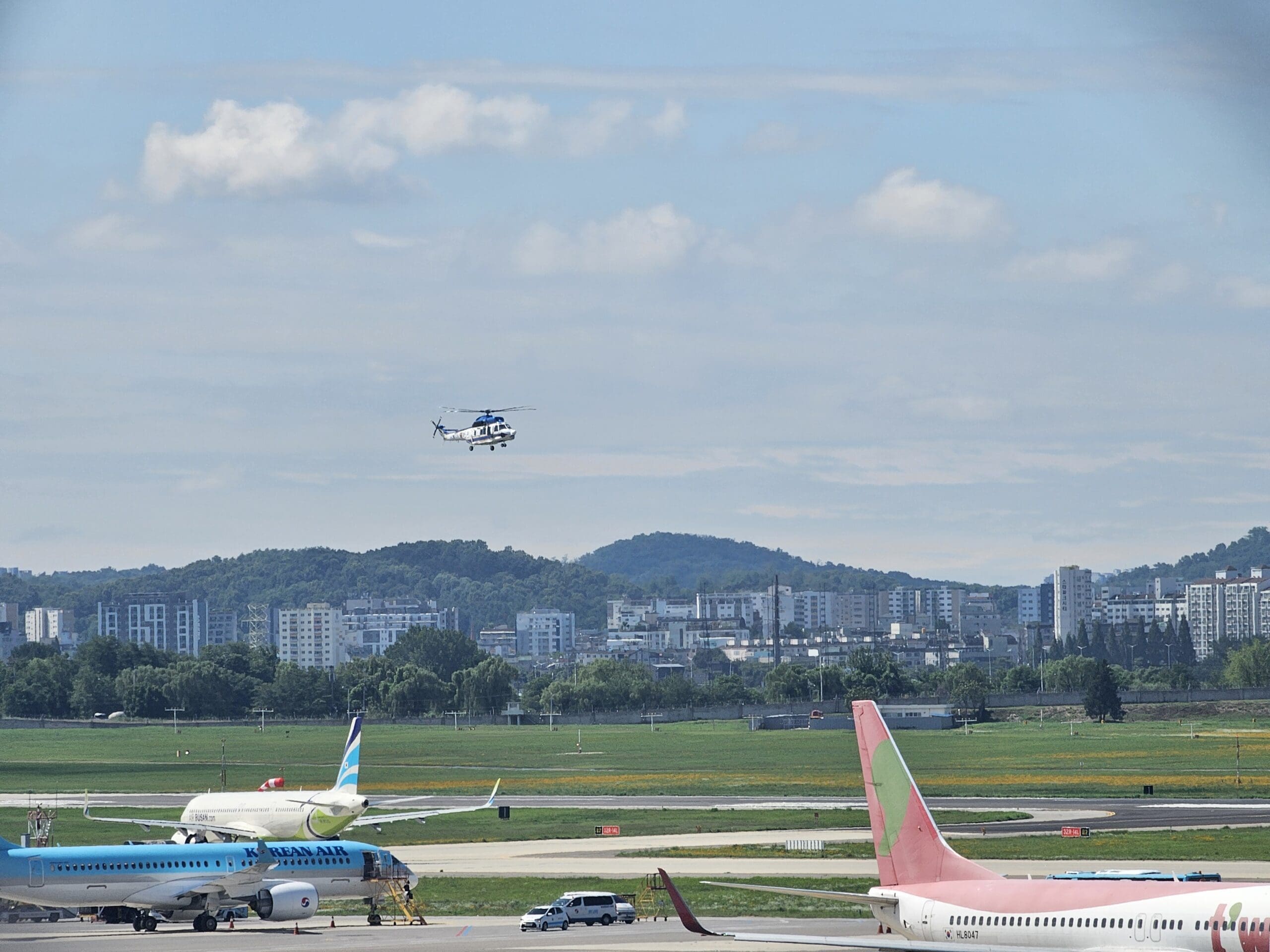
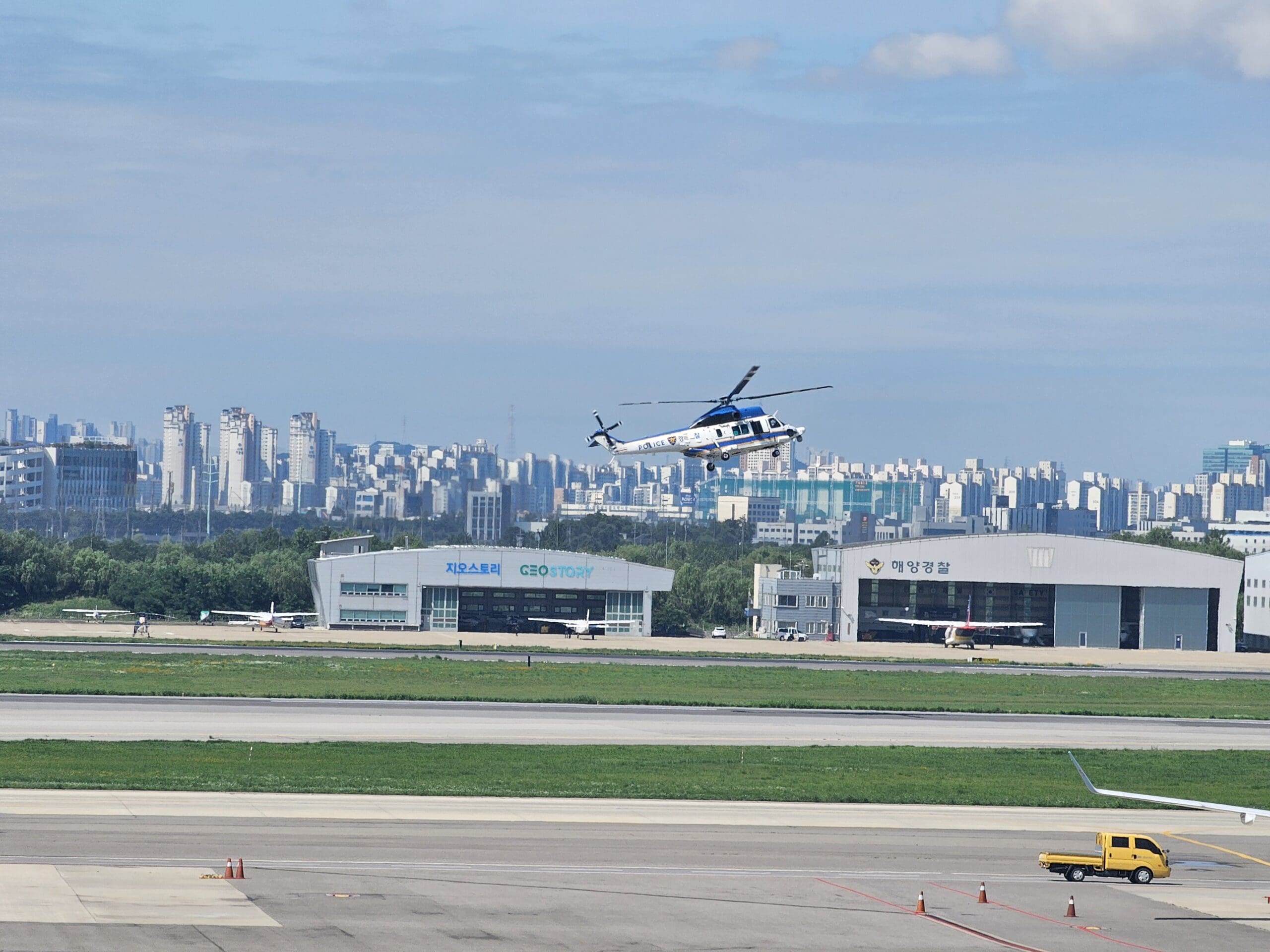
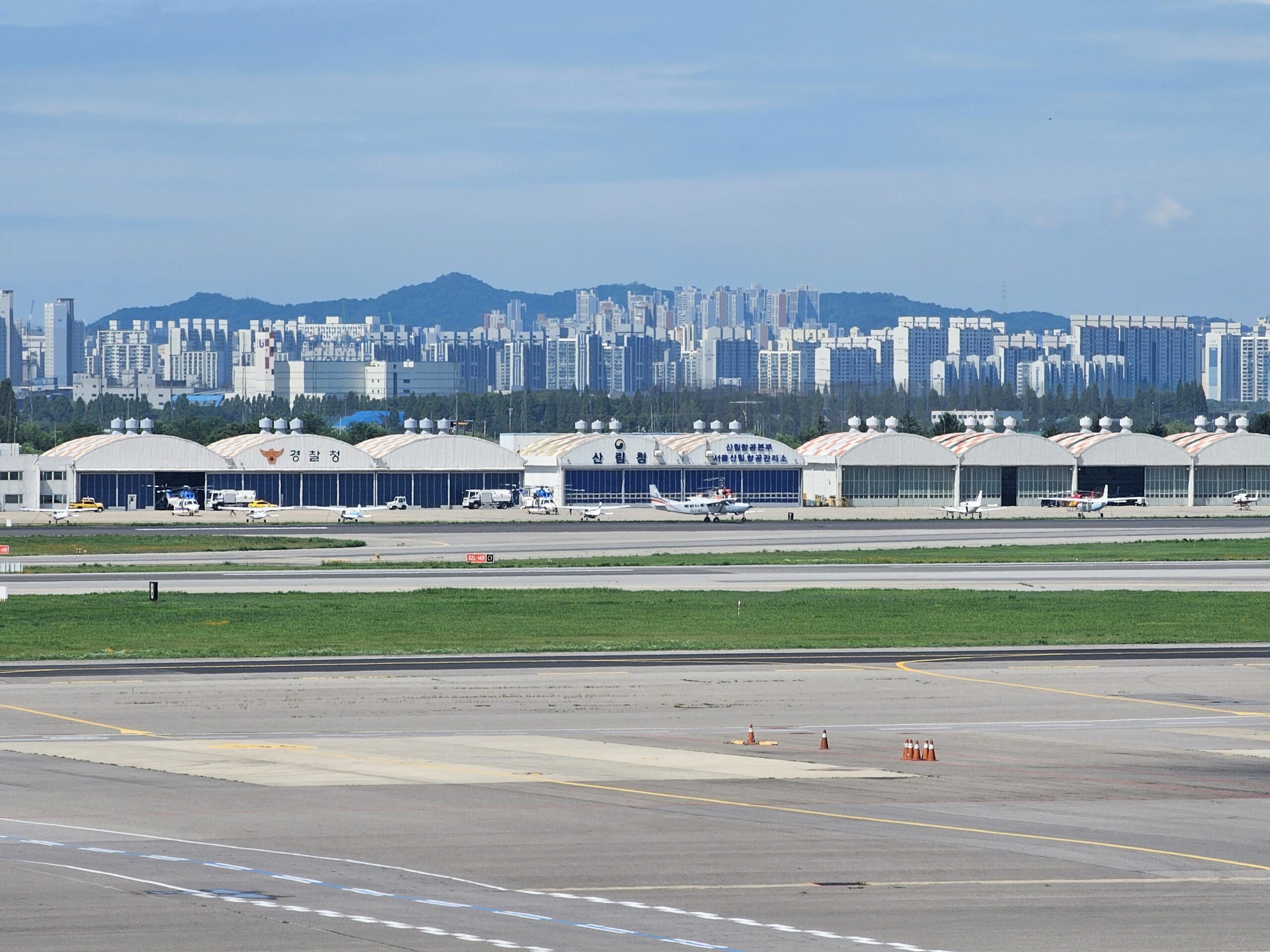
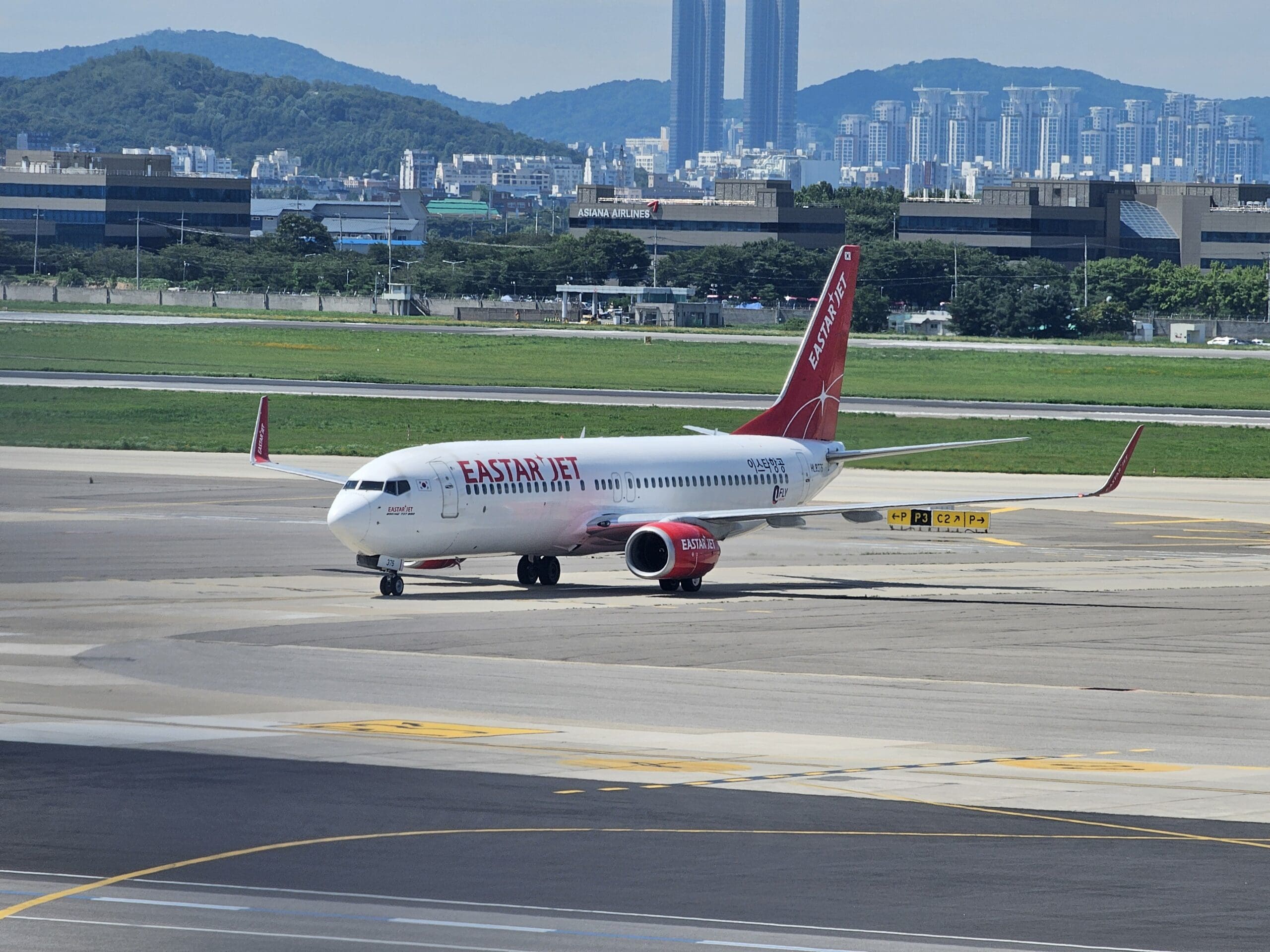
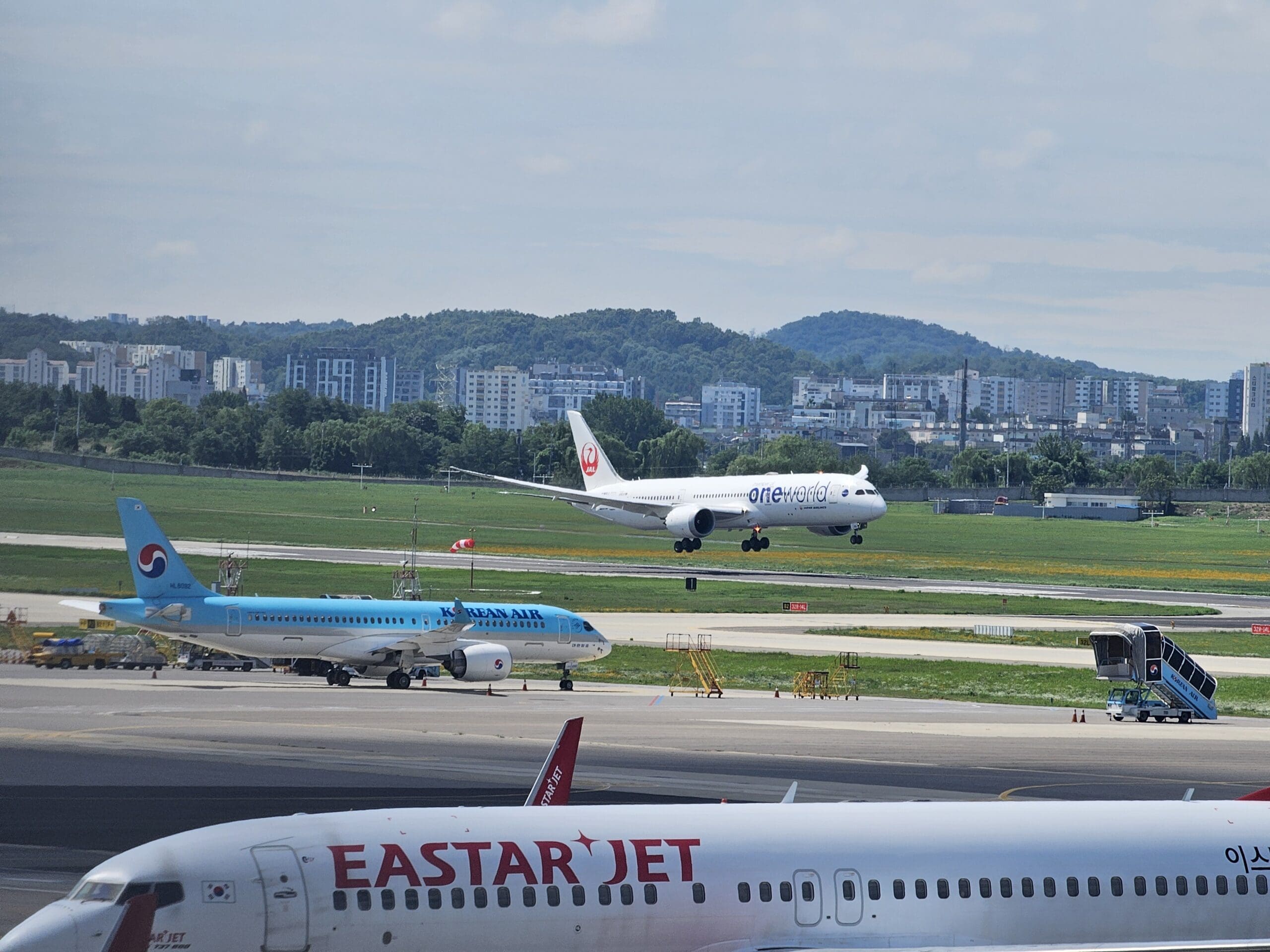
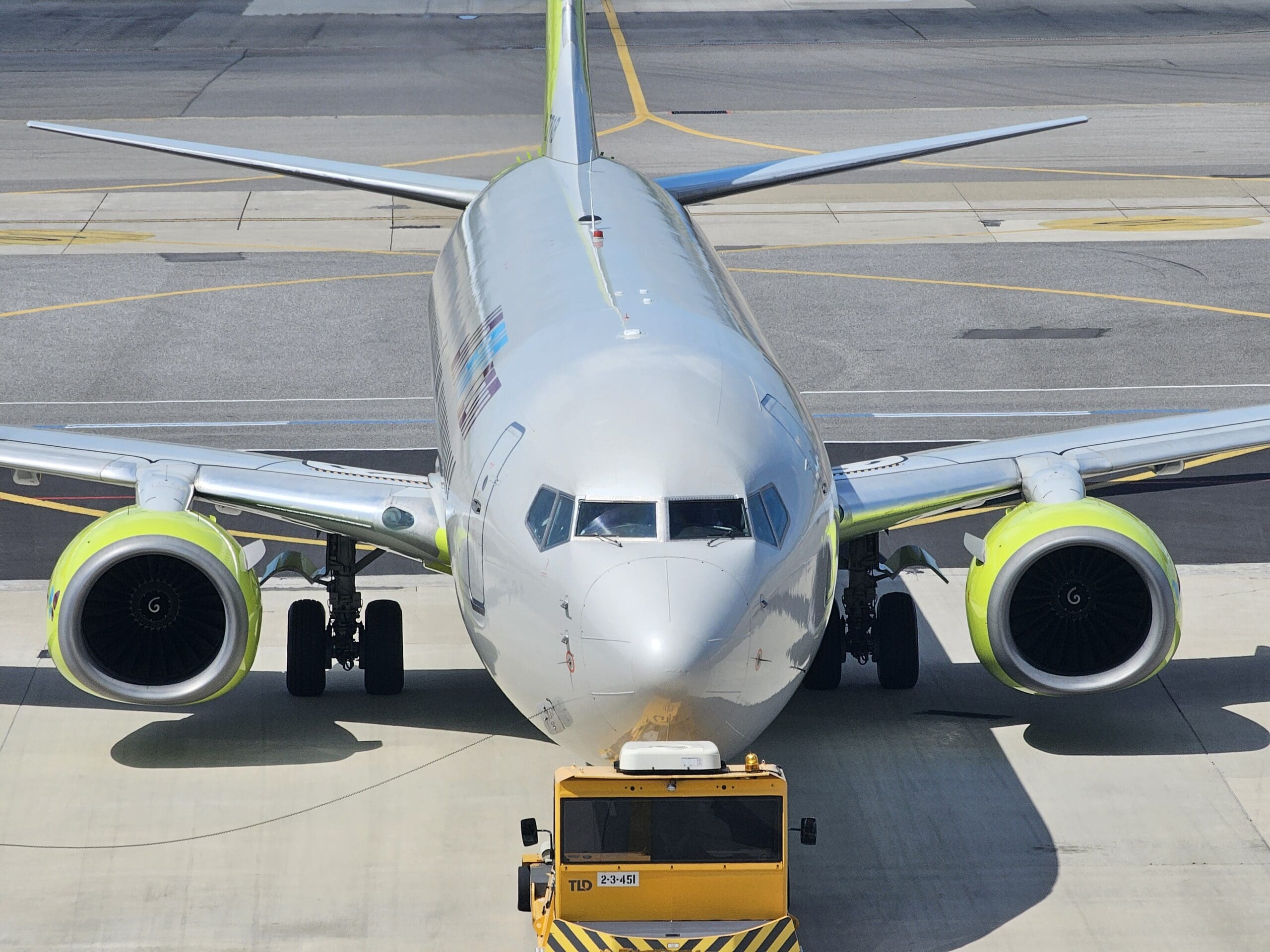
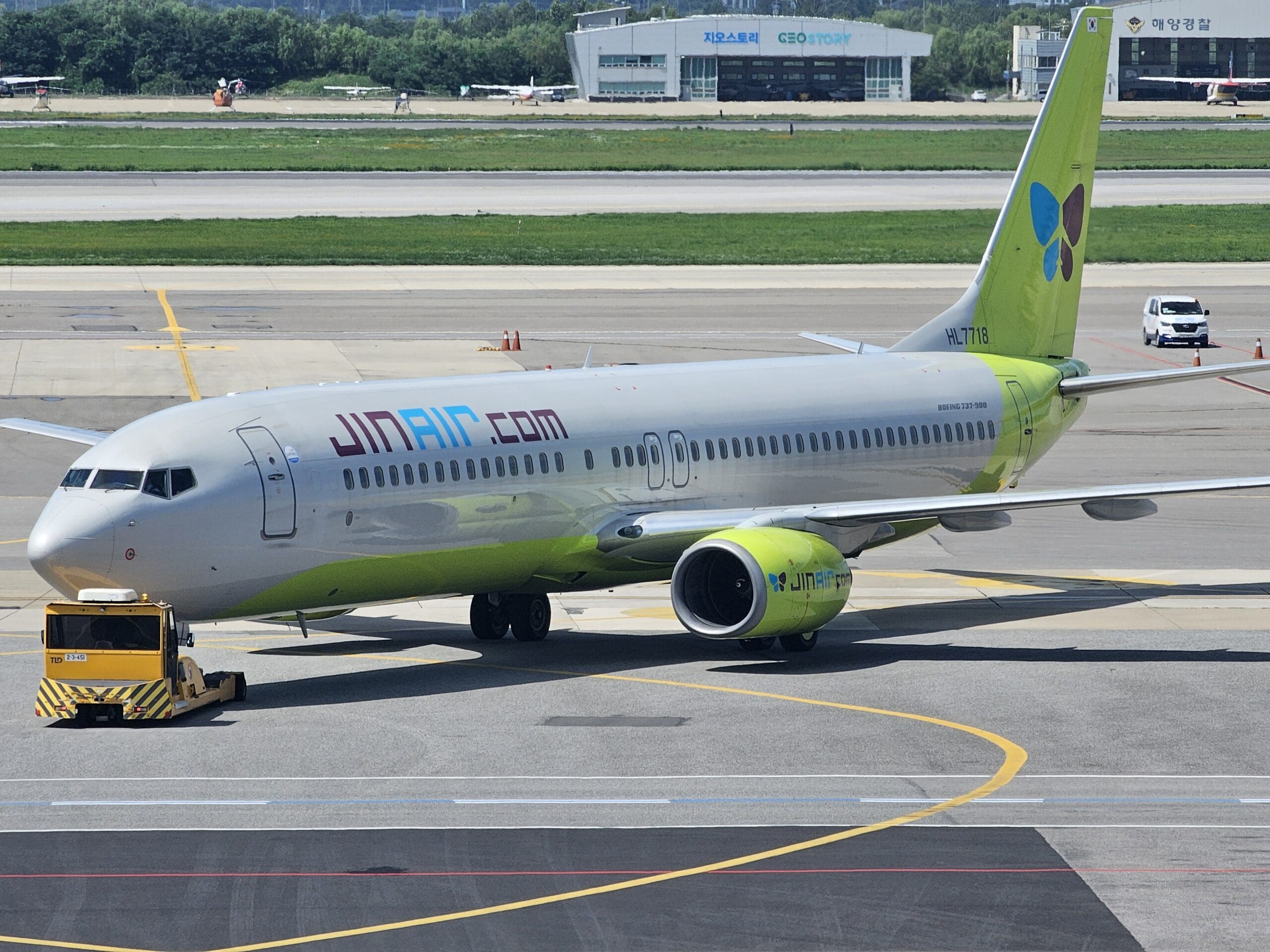
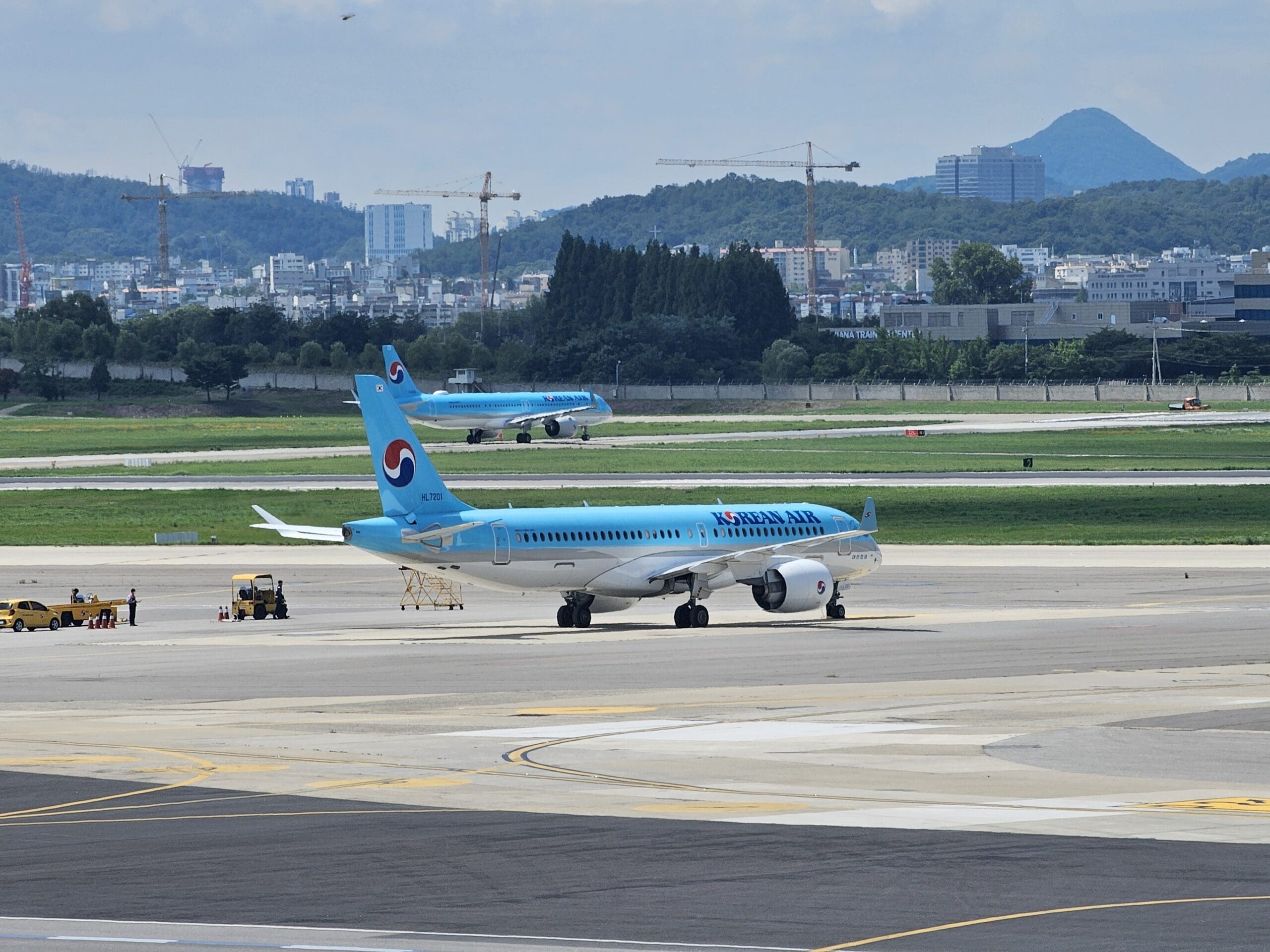
Eventually, fearing that I would get burnt in the bright sunshine and with my layer of suncream already wearing off, I made my way back inside the terminal building. Seeing no point in remaining in the landside portion of the terminal, I headed down the escalators to the security checkpoint. At that time, I was delighted to find there were no queues at the initial identity check, and I was able to walk straight up to one of the agents who scanned my boarding pass and checked my passport before allowing me to continue onwards. Immediately afterwards, I reached the security hall where a row of checkpoints could be seen. Despite the lack of passengers, most of these were manned, and I walked straight up to one where I temporarily parted with my possessions and walked through the metal detector. With no need for any further checks, this was a quick and easy process, and I made it to the airside area less than a minute after entering the security area. Once again, Gimpo Airport proved to be a hub of efficiency, and I could have easily turned up just thirty minutes before departure and safely made it to the gate in time for boarding!
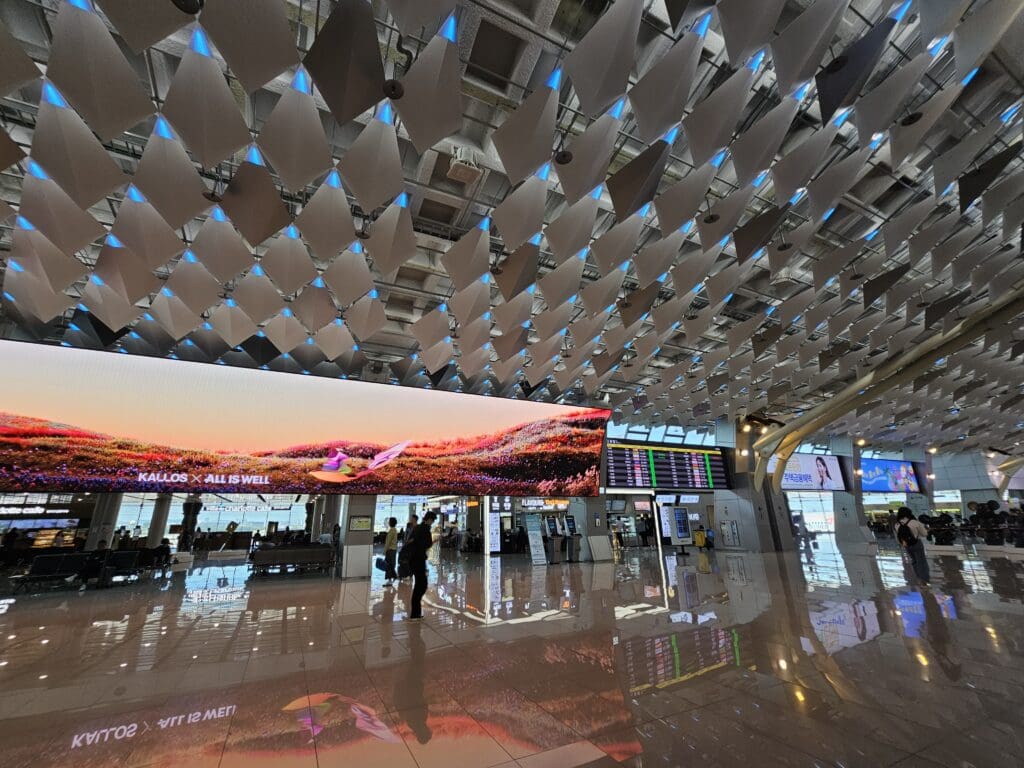
Once airside, Gimpo Airport’s domestic terminal is a little compact and consists of a central hub, home to most of the terminal’s facilities, with two arms branching out from this. Just like the landside portion of the terminal, this is modern, bright, spacious, and airy, and at that time, it appeared to be spotlessly clean and tidy throughout, leaving me with few complaints. However, I should note that this portion of the terminal was not designed with any long waits in mind, and there are fewer facilities on offer there compared to the landside portion of the terminal. Specifically, this features three cafés, three light fast food outlets and a convenience store. Last but not least, throughout the terminal, floor-to-ceiling glass windows offer a good view out onto most of the terminal’s stands as well as the eastern end of the two runways, and thus, this provides aviation enthusiasts with a great place to wait and watch aircraft. However, these windows are slightly tinted, and thus, professional aviation photographers may be a little disappointed.
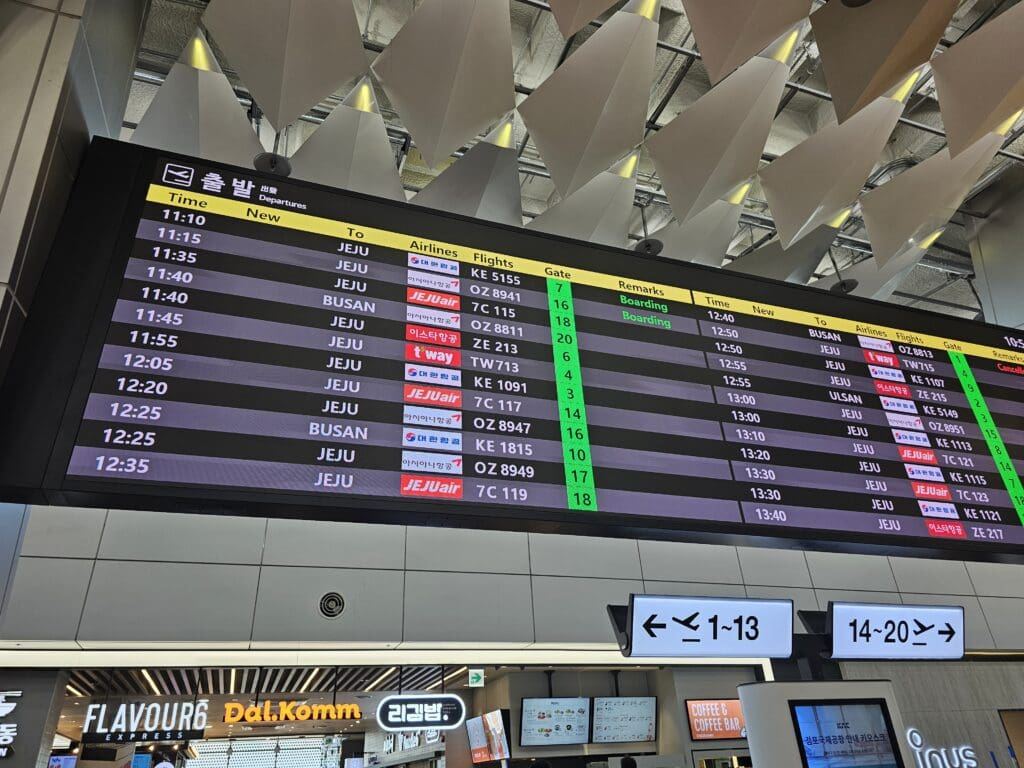
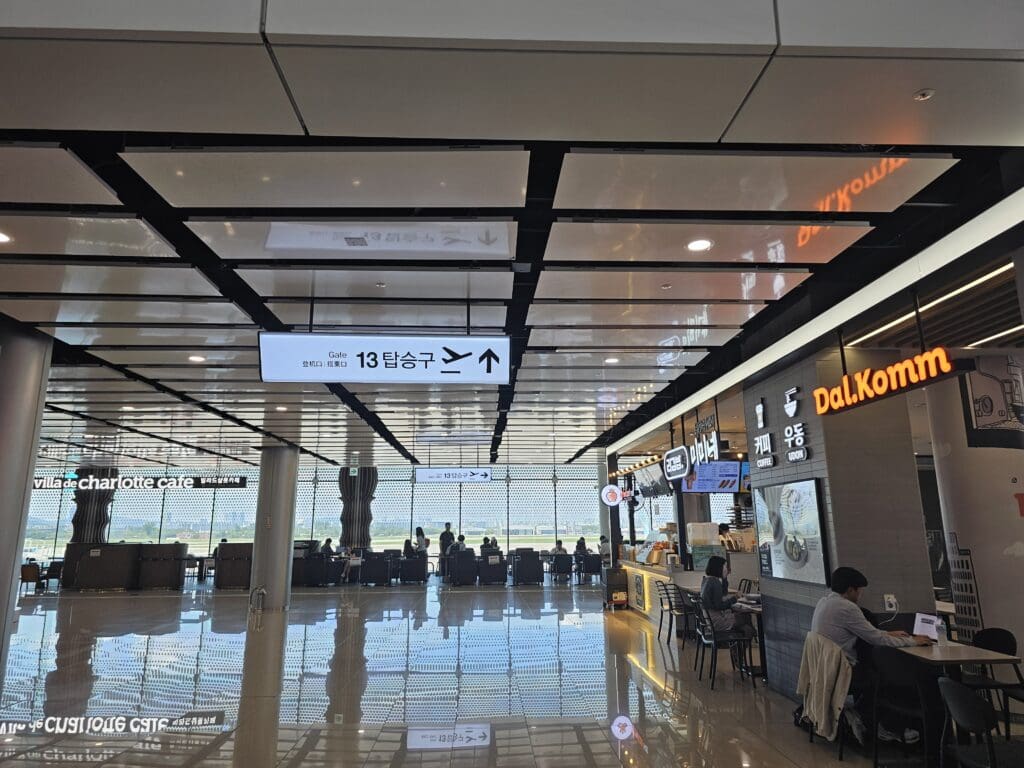
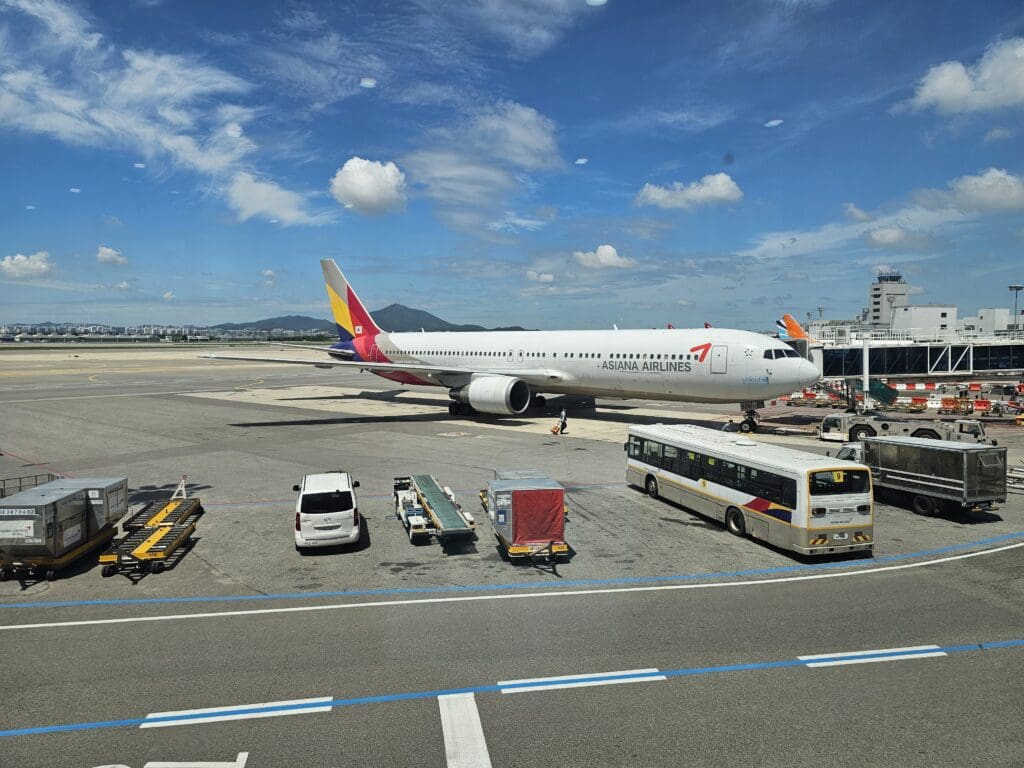
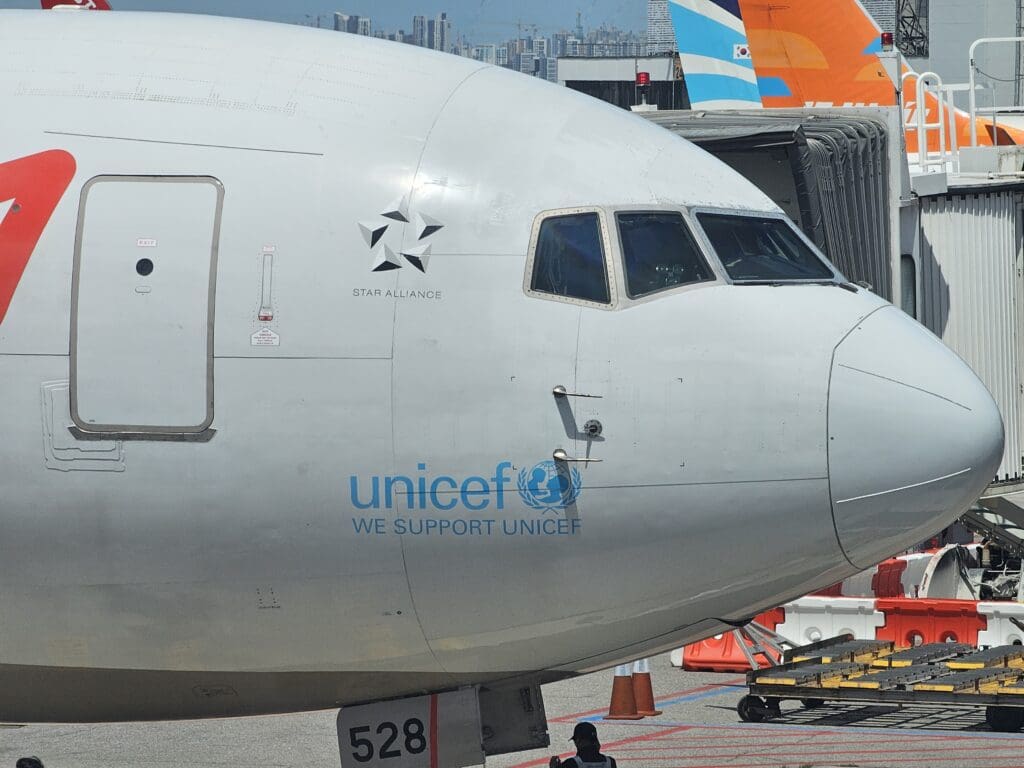
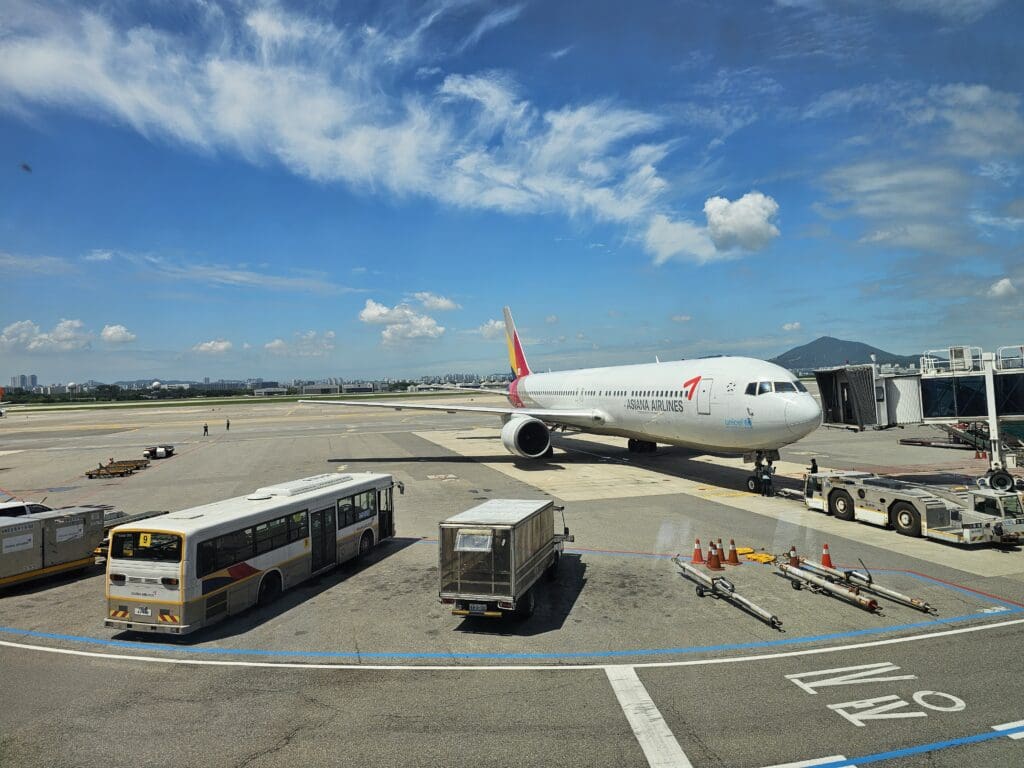
After stopping at the local CU convenience store for a light lunch consisting of a kimbap, I checked the departure boards which revealed that my flight to Jeju would depart from Gate 14, which is conveniently located within the terminal’s central hub. At 1110, I watched as the Boeing that would be operating that day’s 1205 flight to Jeju made a smoky touchdown in Seoul before appearing at the stand a few minutes later. That day, I would be flying on the split-scimitar-fitted Boeing 737-8BK, HL8322. Assembled at Boeing’s Renton plant, this jet first took to the skies of Washington State in February 2007 and was thus a ripe 17.4 years old at the time of my flight. Sporting a bright yellow colour scheme and opposingly sky-blue coloured winglets, later that month, the jet was flown across the Atlantic and commenced operating for the TUI Group’s German arm, TUIfly. There, the aircraft specialised in connecting German holidaymakers with destinations across Europe and North Africa. However, before long, in May 2008, the aircraft was repainted into an all-blue livery and began operating for British sister carrier, Thomson Airways (now known as TUI Airways). For the next few years, the aircraft would operate as G-FDZJ during the northern summer months and from 2010 to 2014, each winter this would head across the Atlantic and operate on behalf of Canadian leisure carrier Sunwing Airlines as C-FRZJ.
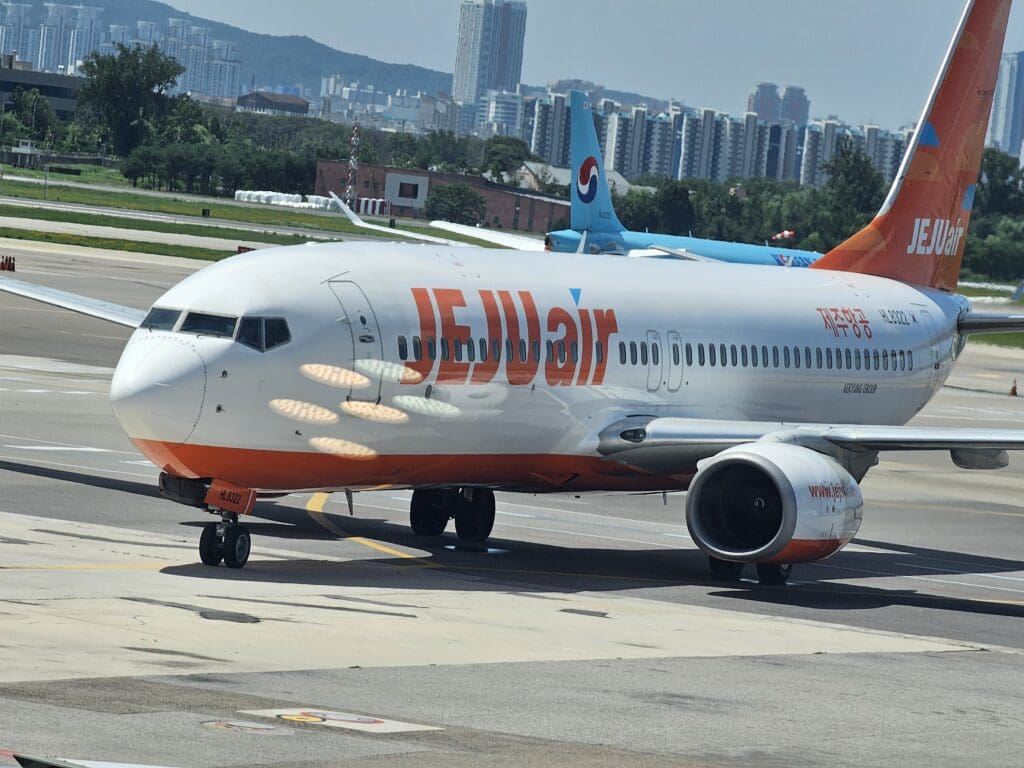
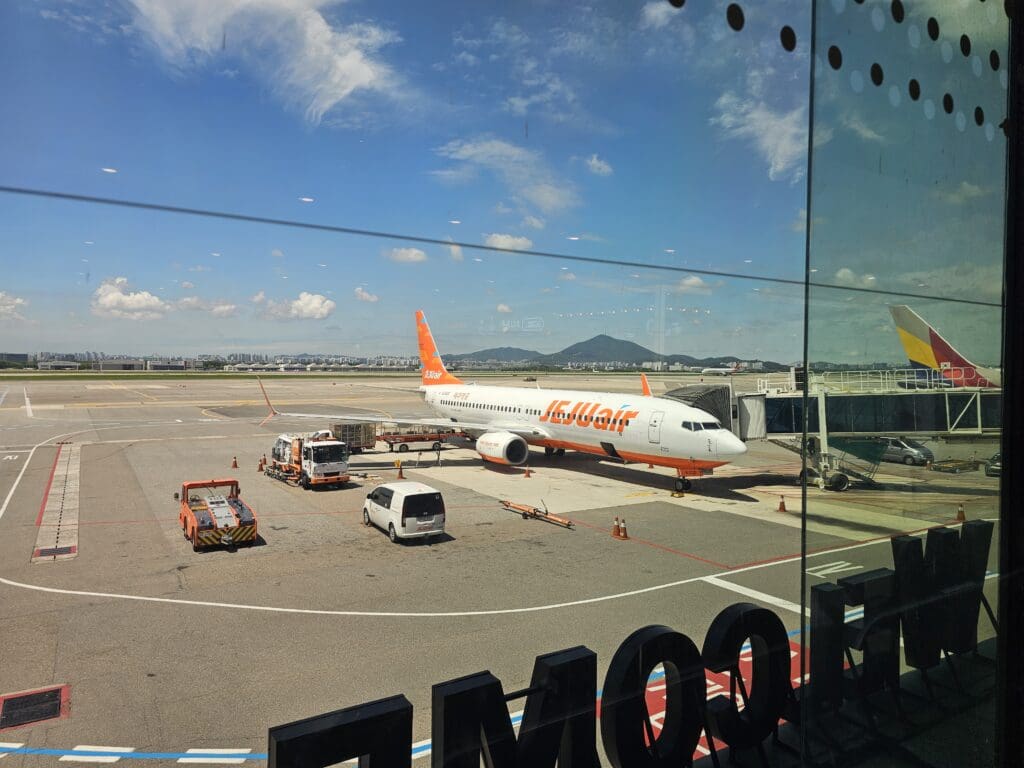
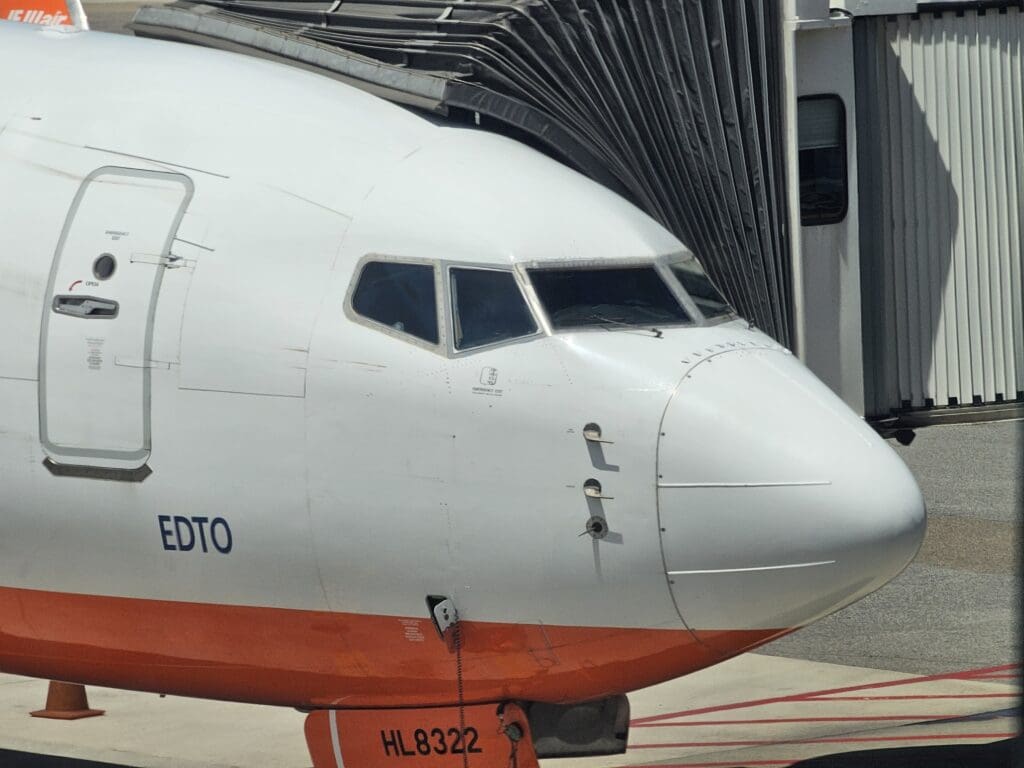
In 2013, the aircraft received the TUI Group’s updated ‘wavy’ livery and the following year, in line with the group’s wider fleet initiatives its winglets were replaced by the sharp futuristic-looking split-scimitar winglets. Meanwhile, later on in 2017, the jet’s Thomson titles were replaced by ‘TUI’. Following over a decade of specialising in transporting Canadian and European holidaymakers to warmer climes, in November 2018 the Boeing was withdrawn from service and returned to its lessor, Aircastle. Initially, this was stored at Abu Dhabi Airport before receiving the temporary Irish registration of EI-GIY and being moved to Shannon, where it was prepared for its new life in East Asia. There, the jet was painted into Jeju Air’s distinctive orange and white livery and in late February 2019, this was ferried to Seoul Gimpo, making a mid-journey stop in the Azerbaijani capital, Baku.
Since 2019, the aircraft has operated to destinations across Jeju Air’s East Asian network, flying a mixture of short domestic hops up to medium-haul slogs down to Southeast Asia. From October 2022 to March 2024, this wore a large decal of Zanmang Loopy, a character from the popular Korean children’s cartoon, Pororo. During its time with Jeju Air, the aircraft was involved in one reasonably well-known incident. This occurred upon landing in Busan in March 2021 and involved the aircraft’s left wingtip coming into contact with the runway following a flight from Seoul Gimpo. This caused the aircraft to undertake a go around before landing safely the second time around. For whatever reason, Jeju Air’s maintenance personnel in Busan failed to detect any damage to the wingtip during their post-landing inspection of the aircraft and this operated its return sector to Seoul before significant damage to this was spotted. Thankfully, in the week before my flight, the aircraft appeared to have completed all of its assigned duties successfully and had been flying almost non-stop. This saw the jet operate services between Jeju and the mainland Korean airports of Busan, Cheongju, Daegu, Muan and Seoul Gimpo. Meanwhile, the aircraft also operated international services between Busan and Cebu and Taipei, and Muan and Dayong and Yanji.
Returning to the journey, as is the norm on most Korean domestic flights, boarding was scheduled to commence twenty minutes before departure at 1145. As this time neared, a reasonably long queue of passengers could already be seen queuing up eager to head off to Jeju. Meanwhile, plenty of gate staff could be seen, with a fair number of signs erected around the gate indicating that boarding would be a calm and orderly affair. A little before boarding was scheduled to commence, an announcement was made advising passengers that boarding would soon begin, requesting that all passengers requiring assistance to make themselves known to staff. However, I should note that this, as well as all boarding announcements, were performed in Korean only.
Keeping to schedule, at 1145 on the dot, passengers were permitted to make their way down the jetbridge and soon joining the queue, I shuffled along for a couple of minutes or so before scanning my boarding pass on the gate scanner. Upon doing this, the gate agent wished me farewell in English and Korean before I headed down the glass jetbridge to the waiting Boeing 737. Following a short queue, I stepped into the Boeing’s forward galley where I received two friendly greetings in Korean from two of the flight’s five cabin crew members, all of whom were dressed in Jeju Air’s distinctive tangerine and cream uniform. Once one flight attendant had checked my boarding pass, I was permitted to head into the aircraft’s 189-seat cabin.
These days when flying with Jeju Air, you never quite know just what the interior of the aircraft is going to look like. Once upon a time, the seats on their aircraft were covered in a grey fabric with a Jeju-themed repeating pattern. More recently, many of their newer second-hand deliveries seemed to have retained the cabin of their former operator, as I had discovered a couple of months earlier when flying on one of Jeju Air’s ex-Norwegian jets. The small number of Jeju Air’s Boeing 737s delivered directly from Boeing feature a modern and smart cabin with grey and orange pleather-covered seats and come complete with a small Business Lite cabin with reclining seats in a 2-2 configuration.
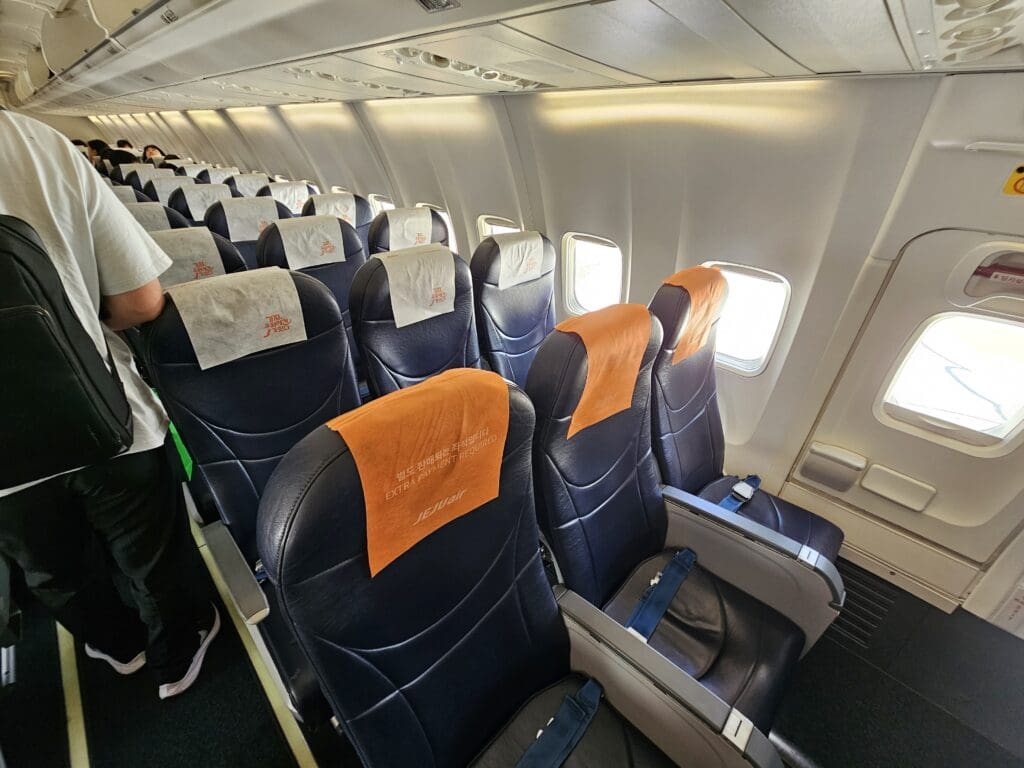
As soon as I entered the aircraft’s cabin and received another friendly greeting, all was revealed and this particular jet retained the slightly dated-looking Recaro seats of its former operator TUI Airways, whilst the former carrier’s light blue mood lighting beamed down during boarding and throughout much of the flight. Adding a Jeju Air touch, each seat sported a disposable fabric antimacassar, with these either being orange for pre-reservable seats, or white with an advert for the Mizuno Wave Rider 27 trainer for the aircraft’s standard seats. Making my way down the cabin, I received a friendly greeting from each crew member that I passed and before I knew it I had reached Seat 24F.

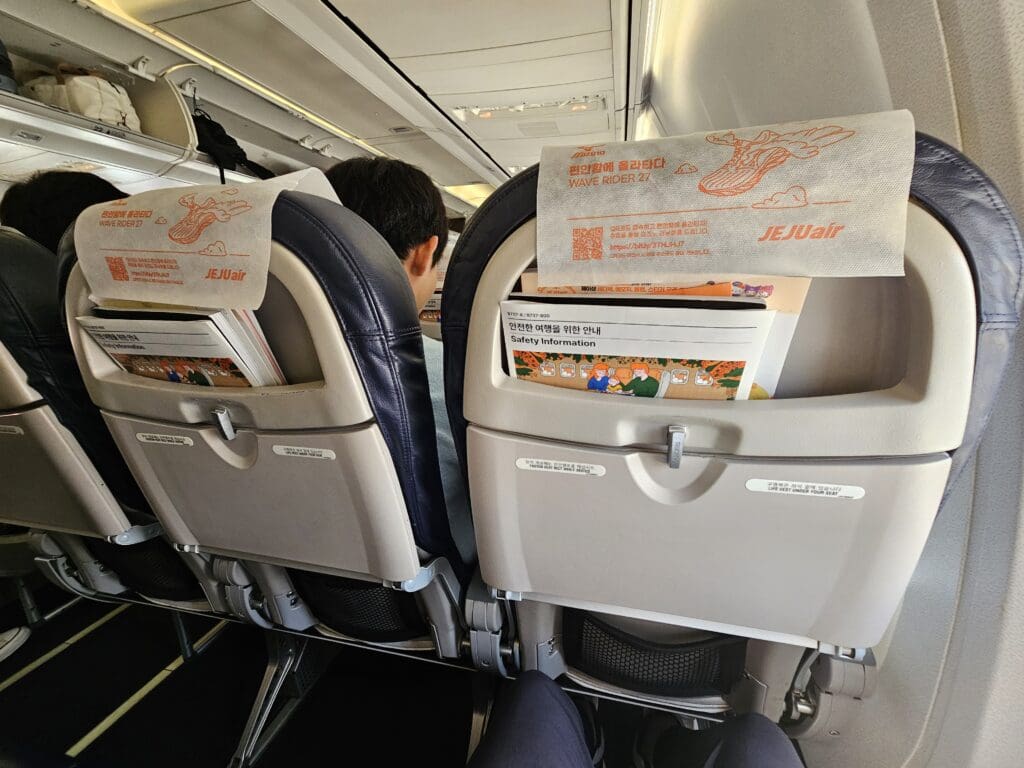
Knowing that I may be trapped in for the duration of the flight, following tradition, I decided to make a quick trip to one of the two lavatories at the rear of the aircraft. Upon opening this up, I found this to be clean, tidy, stocked with the basics and in reasonable condition, thus leaving me with nothing to complain about.
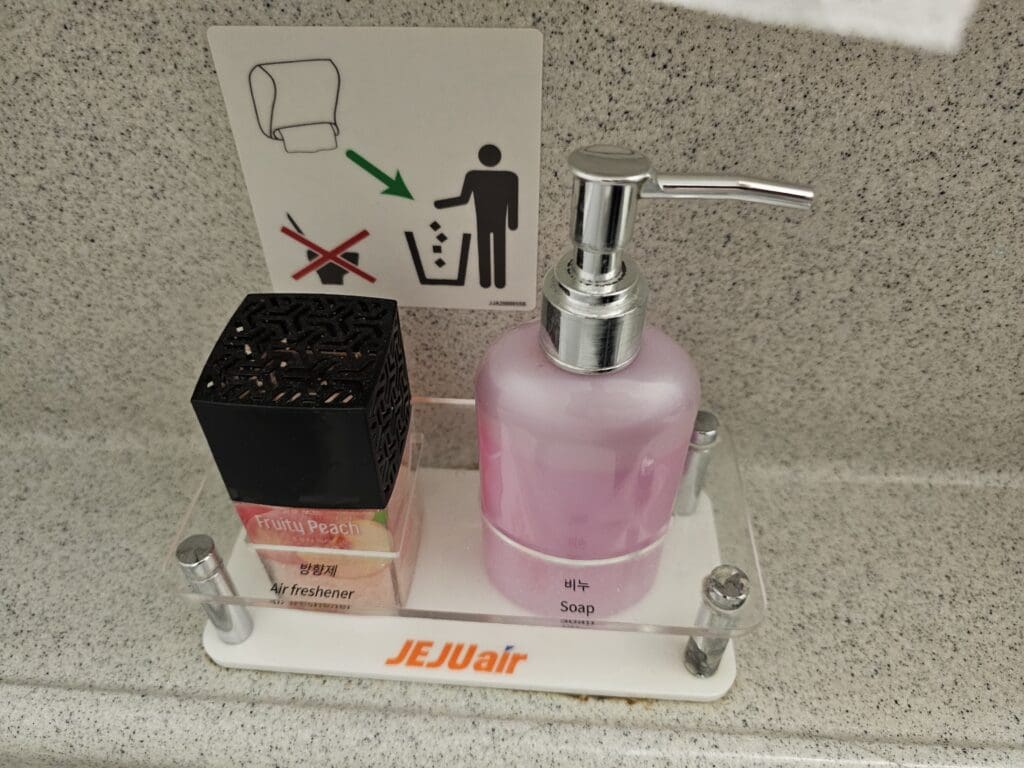
Once back at my seat, I slid in and settled in for the short journey ahead. Despite being a short flight, I was pleased to find the seat to be acceptably soft and comfortable, and I was left with zero complaints about this. When it came to legroom, whilst this was not the most spacious seat that I have ever sat in, this was far from cramped and most certainly offered better legroom than I had suffered on my recent flights with Air Busan and Jin Air. Importantly, the area around my seat seemed to be spotlessly clean, whilst wear and tear was limited to the odd mark and scratch around my tray table and the aircraft certainly did not seem to be in a bad state for its age. Turning to the literature compartment, this contained Jeju Air’s very nicely designed safety card, a sick bag, no fewer than two onboard shopping catalogues (one of which contained Jeju Air’s inflight menu) as well as a card from the Korea Disease Control and Prevention Agency that detailed the latest Quarantine Inspection Requirements.
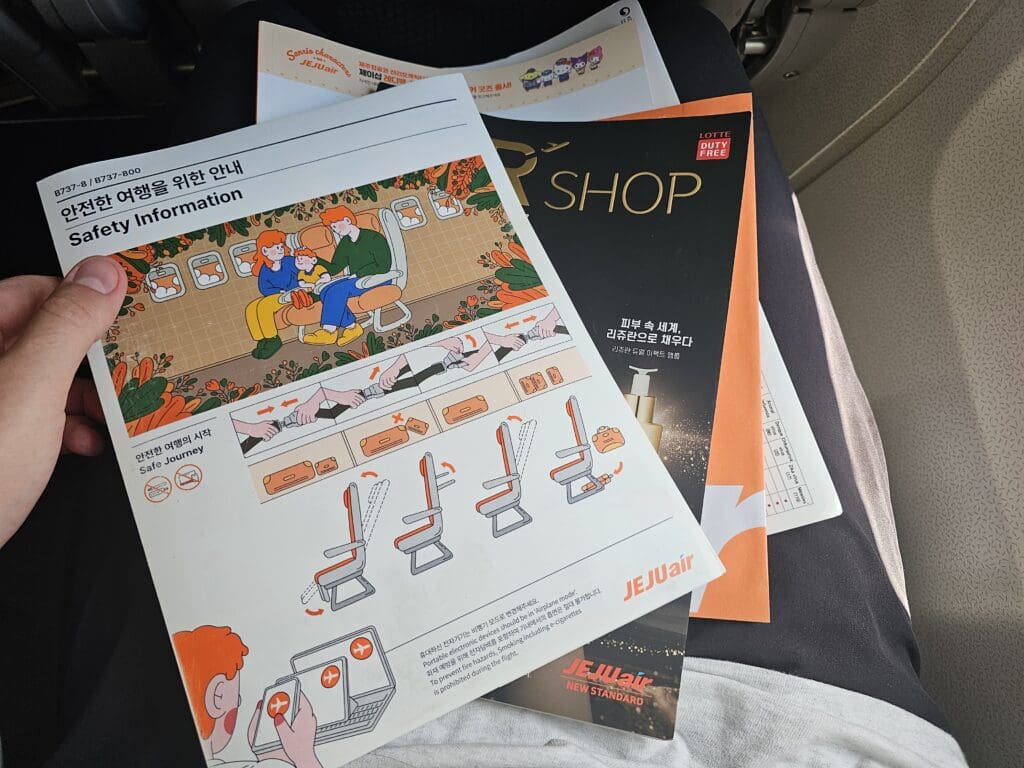
As passengers made their way onto the aircraft, calming yet upbeat music rang out and it wasn’t long before I was joined by two elderly seatmates. Making me thankful that I had made a pre-departure trip to the lavatory. Once seated both of my neighbours seemed to pass out and did not wake up until the aircraft had pulled onto its stand in Jeju! That lunchtime, all passengers made it to the aircraft on time, and at 1200 the final passenger boarded the jet. Looking around, the flight seemed to be virtually full, and I failed to spot any empty seats in my section of the aircraft. As is usually the case, many of those around me took the form of Jeju-bound tourists, interspersed by the odd smartly dressed business traveller. Almost as soon as the final passenger had safely made it onto the aircraft, the cabin door was closed; however, down below, it took a few more minutes until all passengers’ luggage was loaded into the holds.

With a minute to go until our scheduled departure time, all ground service equipment was removed from around the aircraft and inside the cabin the Purser conducted a very short welcome announcement in Korean only, accompanied by a bow by two crew members in the aisle. This soon transitioned into a bog-standard safety demonstration, which consisted of several crew members undertaking a safety demonstration in the aisle to the soundtrack of a pre-recorded safety announcement in Korean and English. After which, the crew members passed through the cabin ensuring that all was secure and in place for our departure. Even though all seemed to be ready for our departure, our scheduled departure time came and went with no sign of any movement. Indeed, a few minutes after our departure time, the Captain’s voice filled the cabin once more as they apologised for the delay and advised passengers that due to air traffic control restrictions in Jeju, our pushback had been pushed back to 1220.
Eventually, at 1222, the Boeing jolted backwards and its two CFMI CFM56-7B27 spooled into life with plenty of humming and vibration, whilst the scent of jet fuel temporarily filled the cabin as these spooled up. Eventually, the aircraft’s flaps were partially extended with a whine, and we commenced our short taxi to the end of Runway 34R. Sitting on the right-hand side of the aircraft, during this short journey, little could be seen other than an Air Busan Airbus A321 touching down on Runway 34L following a hop up from Jeju, and a Korean Air Boeing 737-900 and T’way Air Boeing 737-800 rocketing down the runway at the start of their journeys to Jeju.
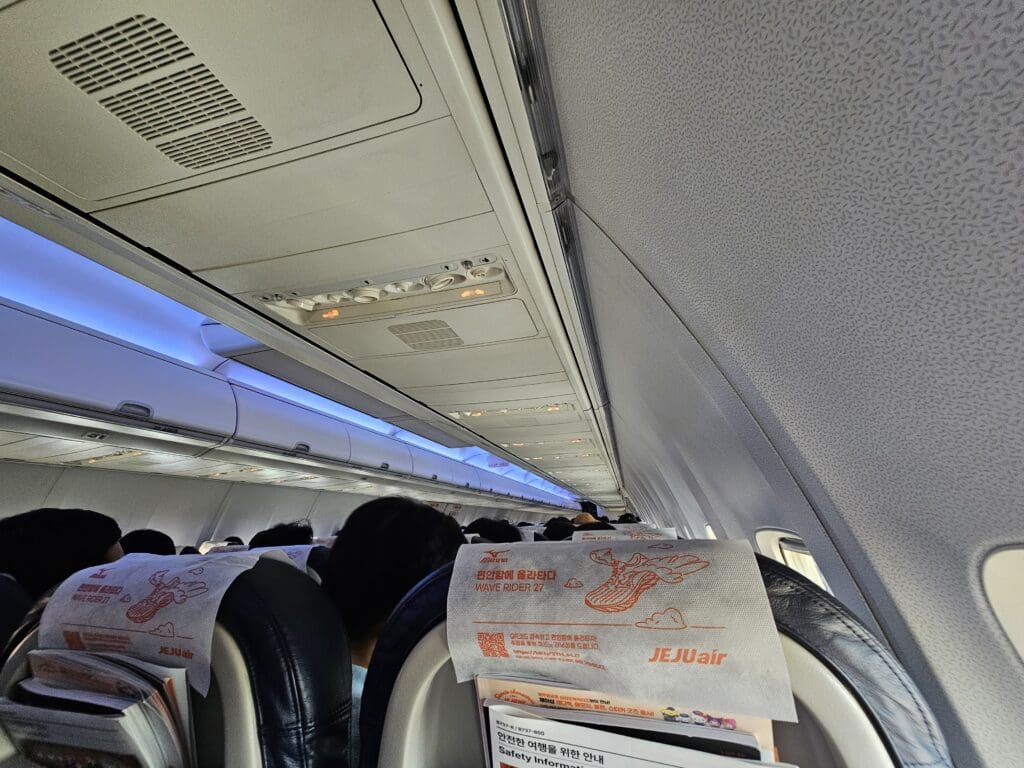
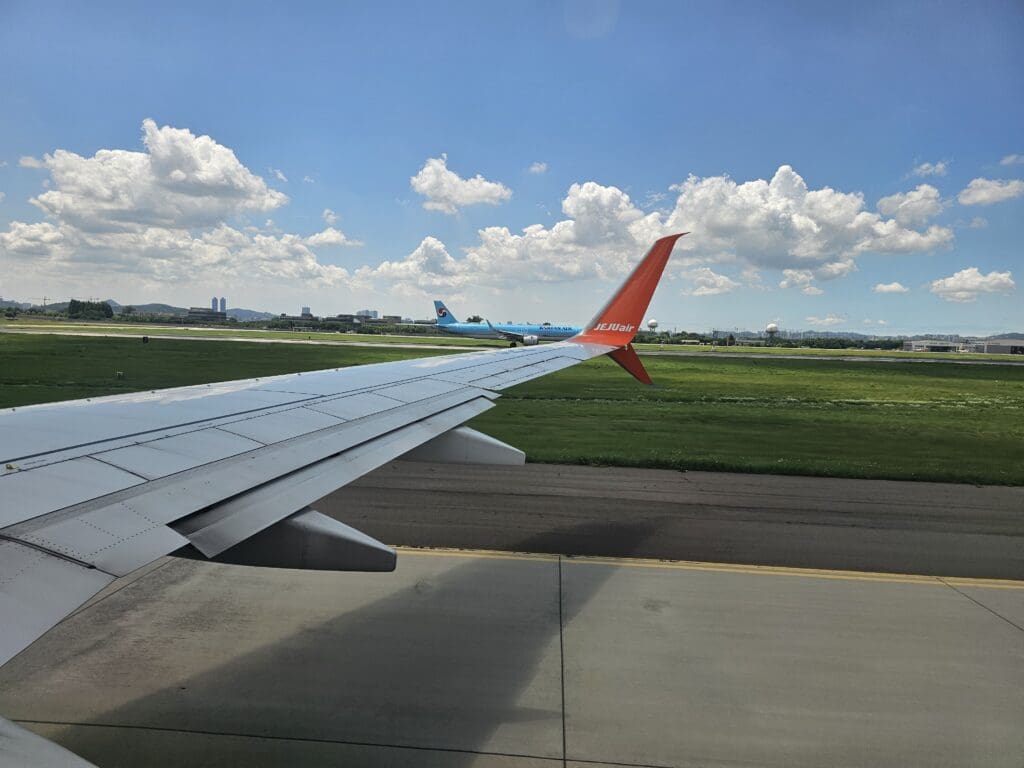
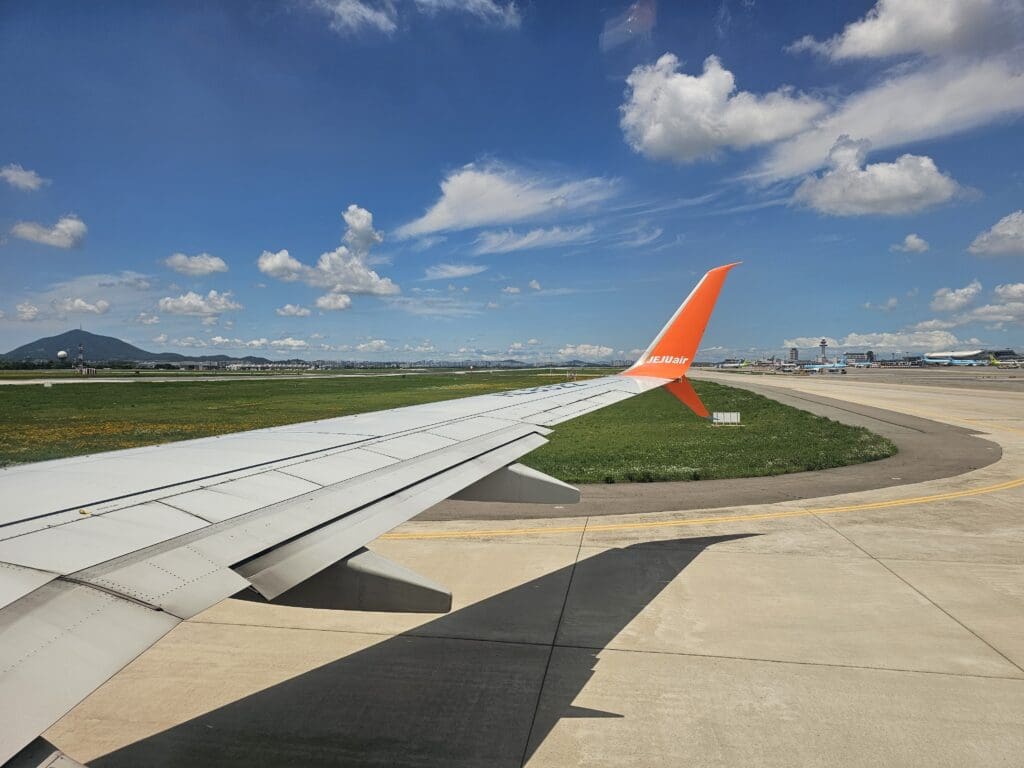
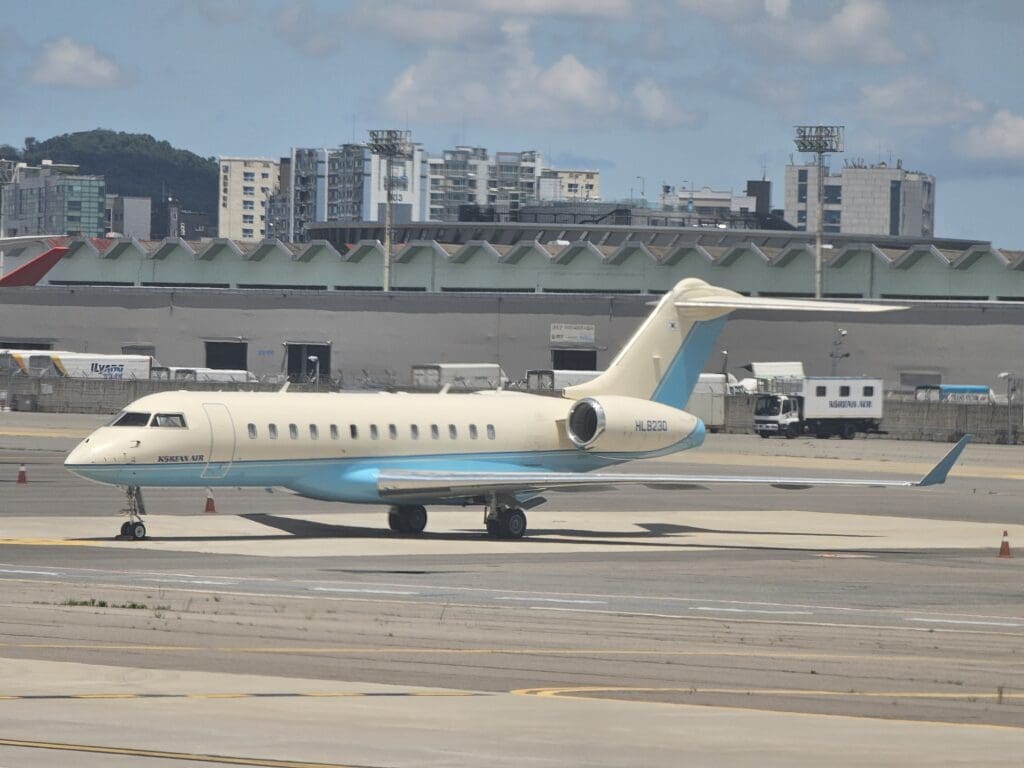
Following a short taxi, without stopping, the Boeing made its way onto the runway and performed a powerful rolling take-off. Swaying from side to side a little as we powered the runway, we accelerated past the airport’s domestic terminal followed by the international terminal where the nose was pointed skywards and we took to the skies with plenty of vibration. Thanks to the wonderfully clear weather, I was offered a superb view of the green fields that sit to the north of Gimpo Airport whilst the mountains of Seoul’s Bukhansan National Park were visible in the distance to the north. Travelling parallel to the Han River, soon, the rows of apartment blocks of Gimpo City could be seen before we commenced a gentle bank to the left that would eventually see us roll out on a southerly heading.
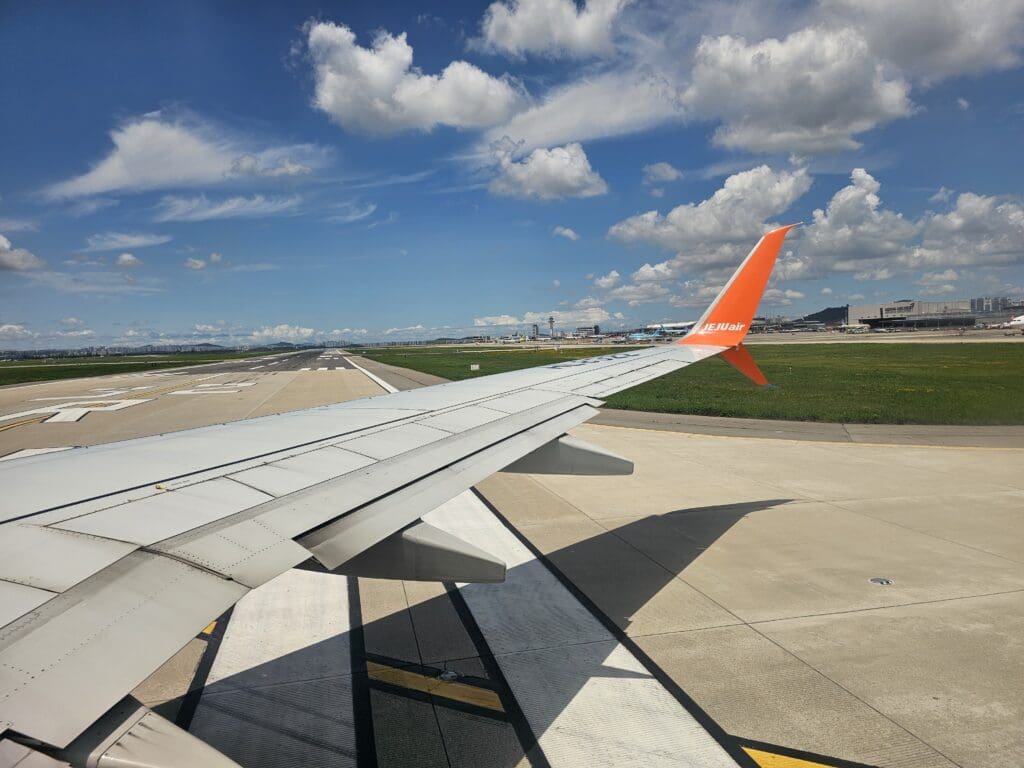
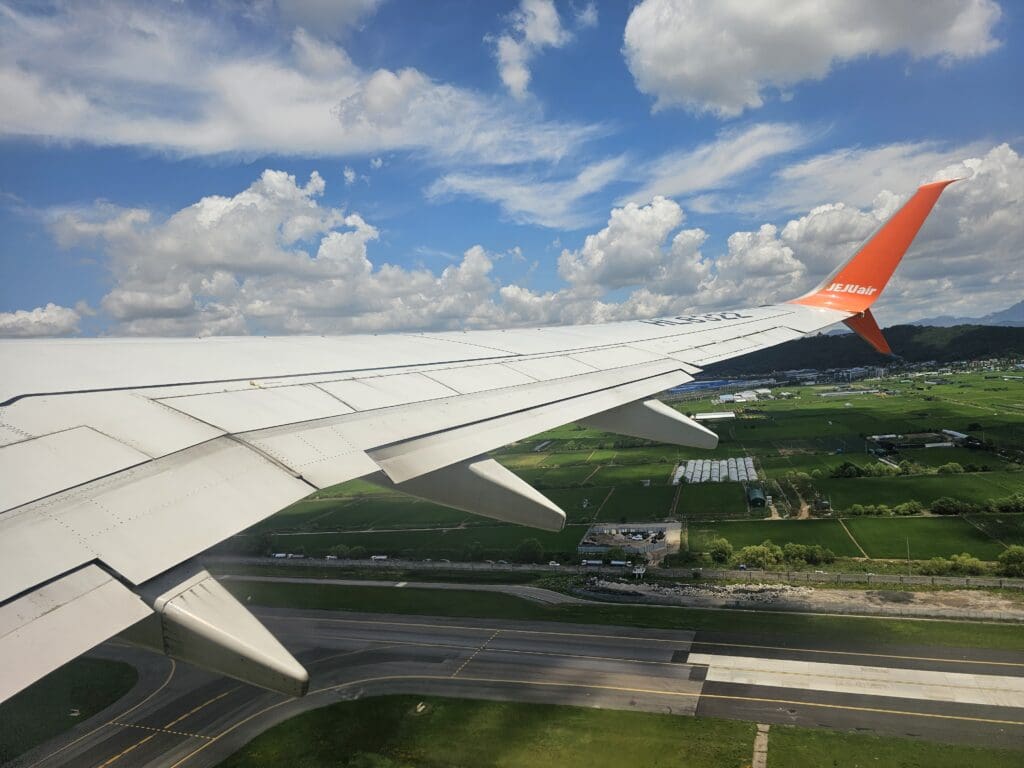
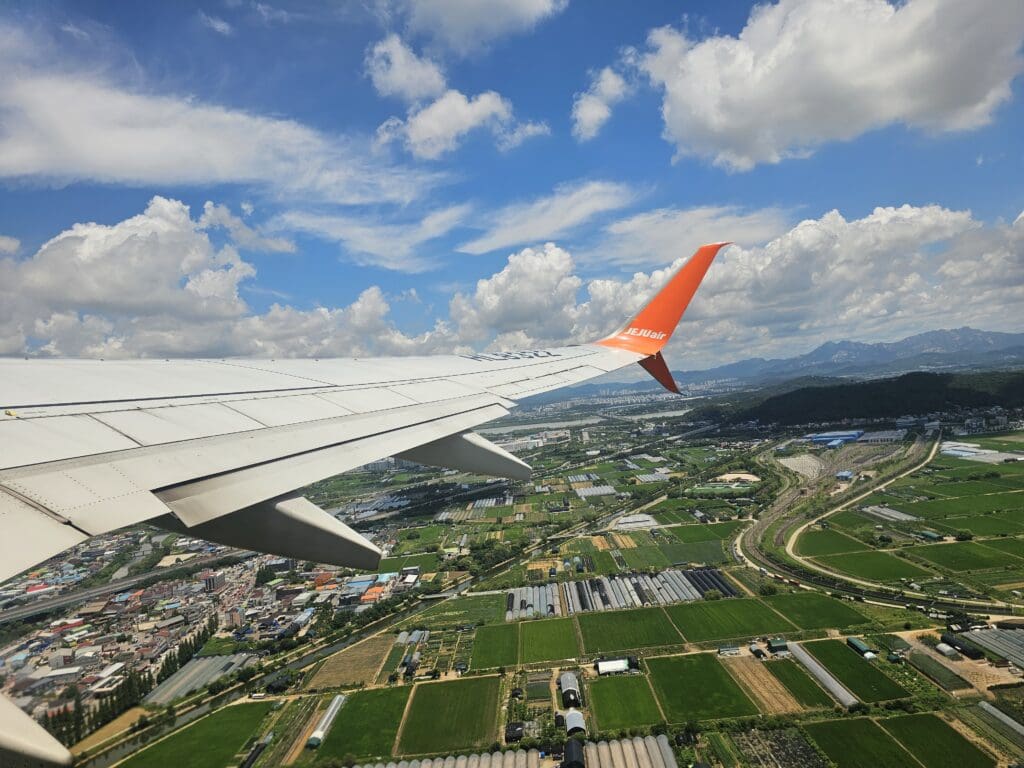
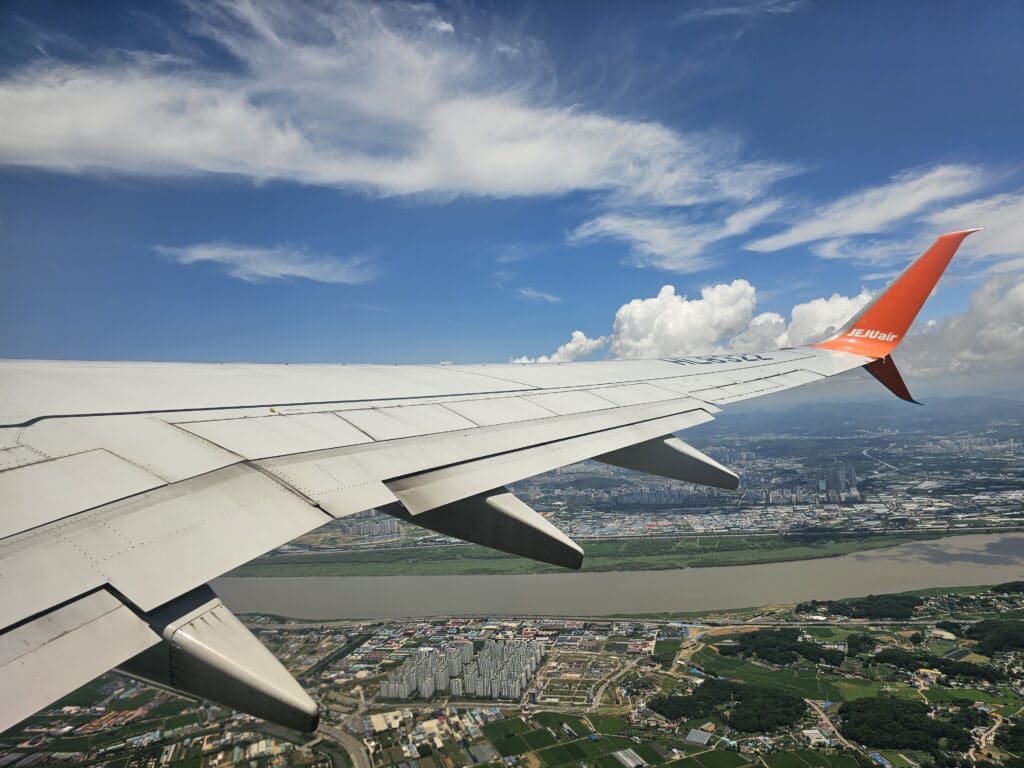
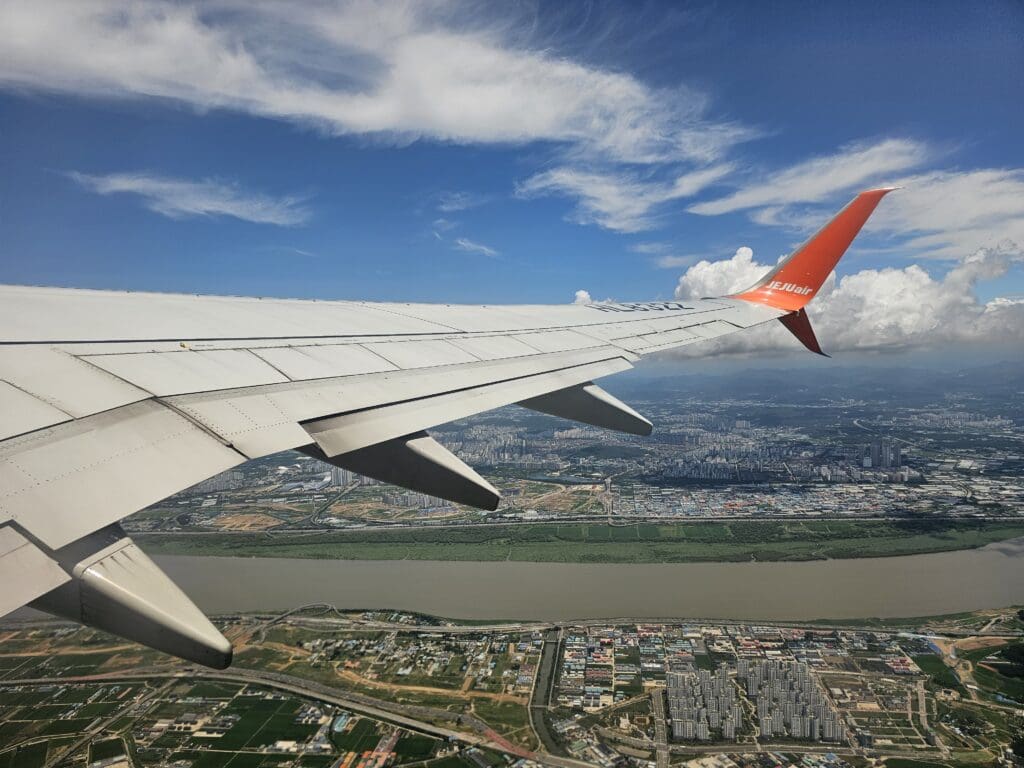
As the aircraft banked, highlighting just how close Seoul sits to the border with North Korea, the fields and mountains of the country’s Panmunguyeok county could be seen around the village of Amsil, just to the south of the city of Kaesong. With little seen other than the region’s greenery, it was easy to forget that I was looking straight at one of the most heavily militarised areas in the world! Soon, vistas of North Korea were replaced by the fields and mountains of the South Korean island of Kanghwa in the distance and the sprawl of industrial and residential buildings along the border between Gyeonggi Province and the city of Incheon below.
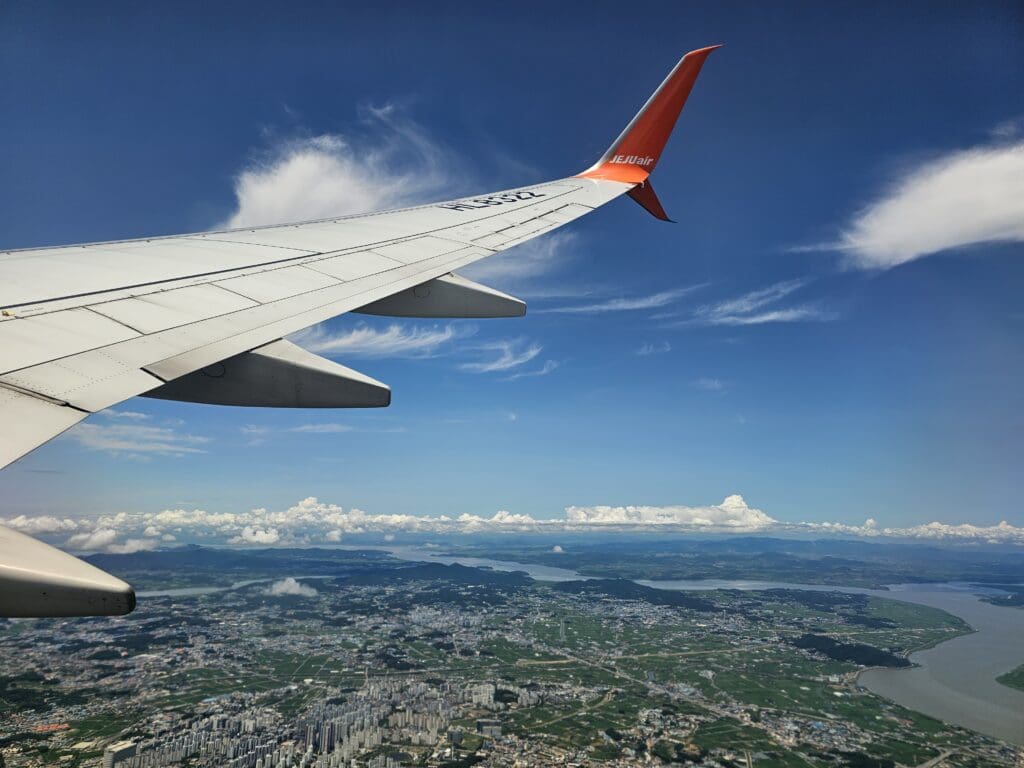
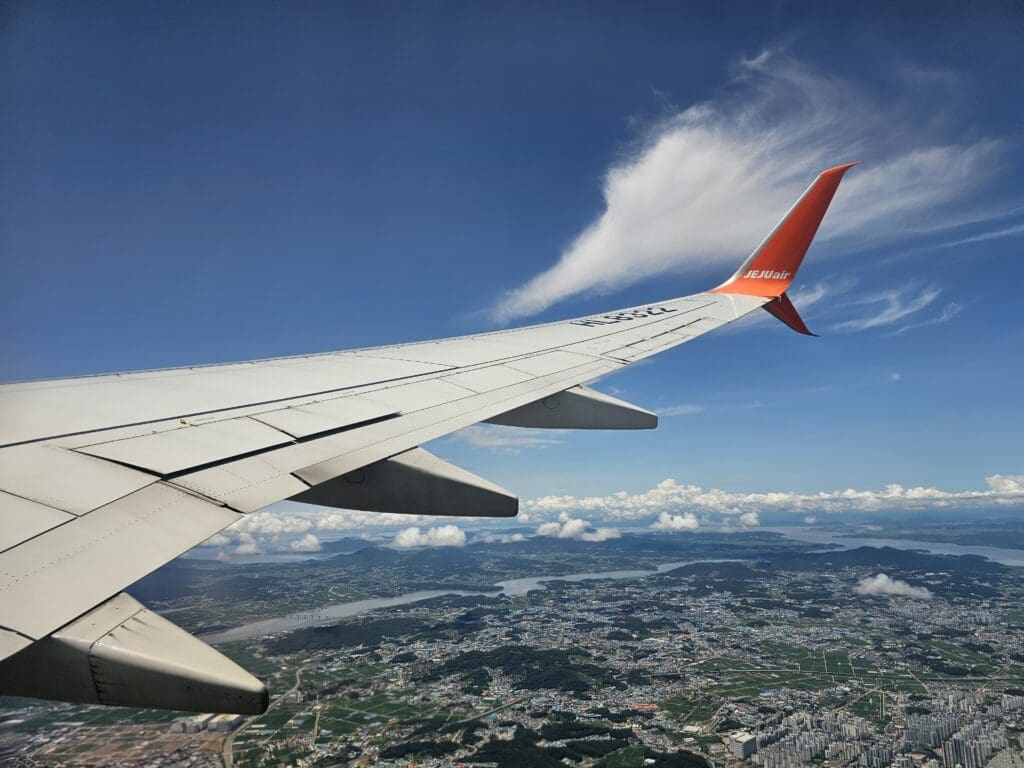
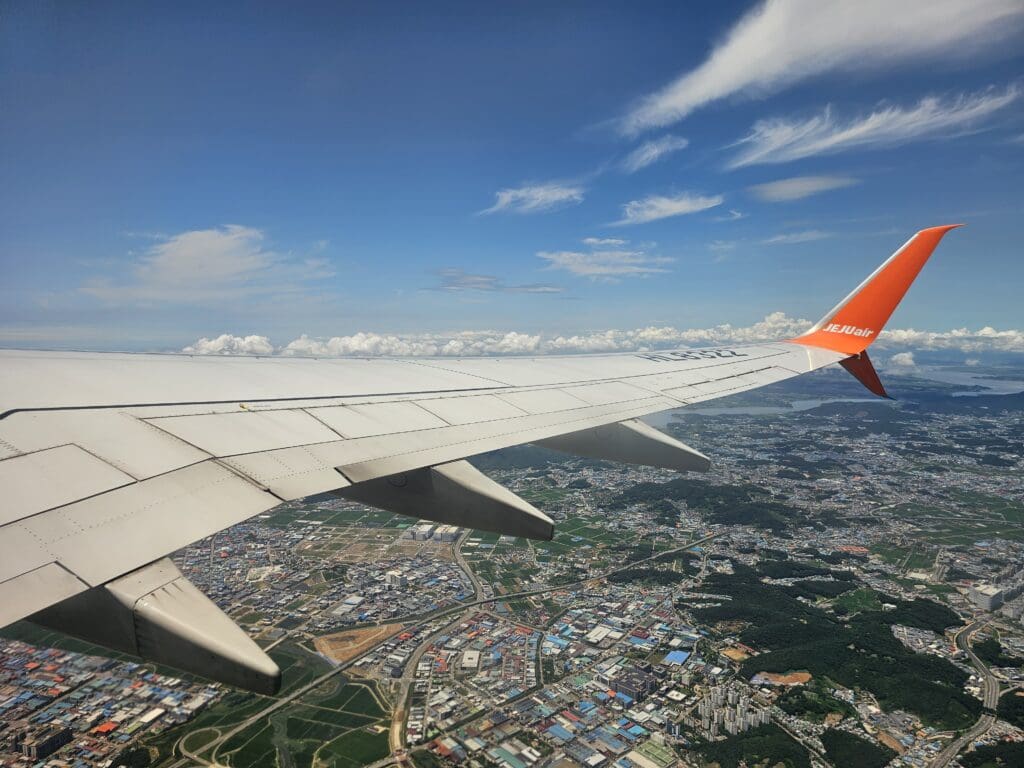
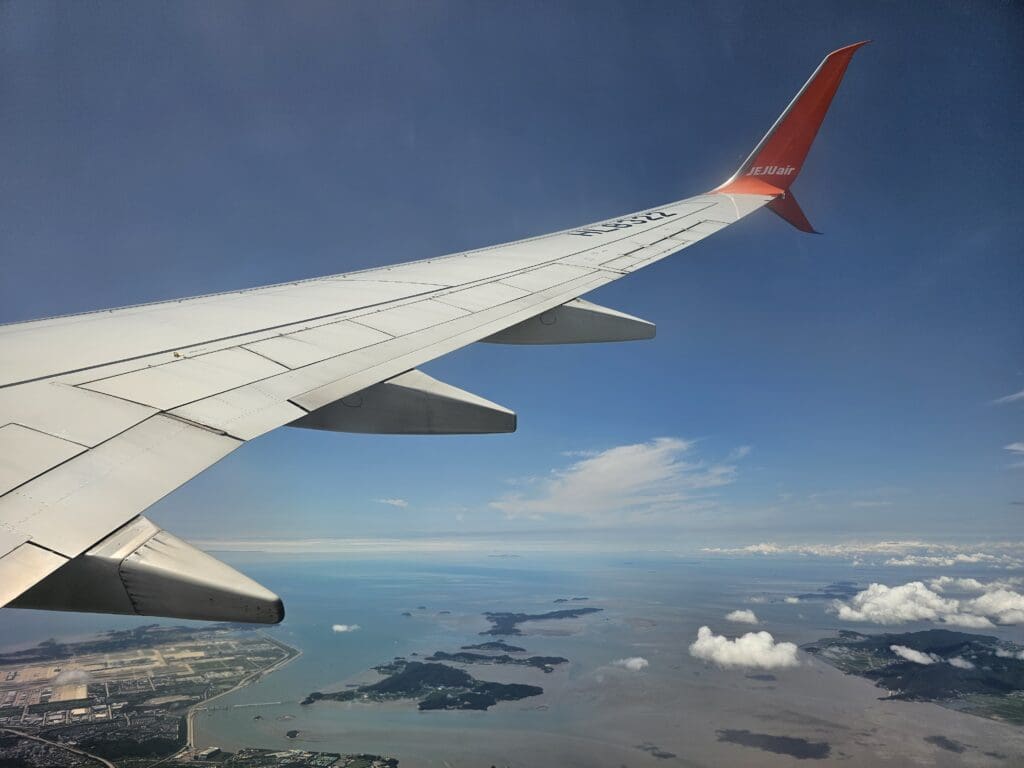
Around five minutes after taking off, the Boeing rolled out on a southerly heading and a fantastic view of the sprawl of Incheon Airport could be seen below on Yeongjong Island. However, this didn’t last long and we soon continued heading southwards over the stretch of sea that separates Yeongjong from the city of Ansan. At this stage, tens of islands could be seen off Korea’s coastline, many of which are inhabited and can only be reached via ferry from Incheon. After passing the cities of Ansan, Hwaseong and Pyeongtaek, the Boeing made landfall over the north coastline of South Chungcheong Province near the city of Dangjin.
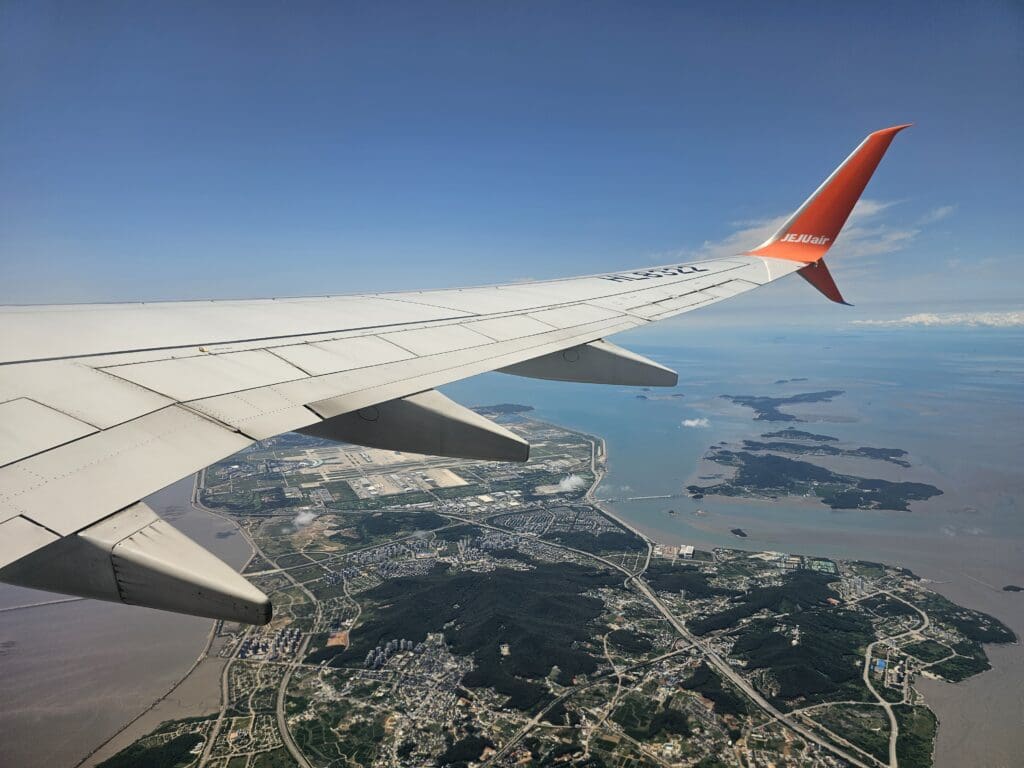
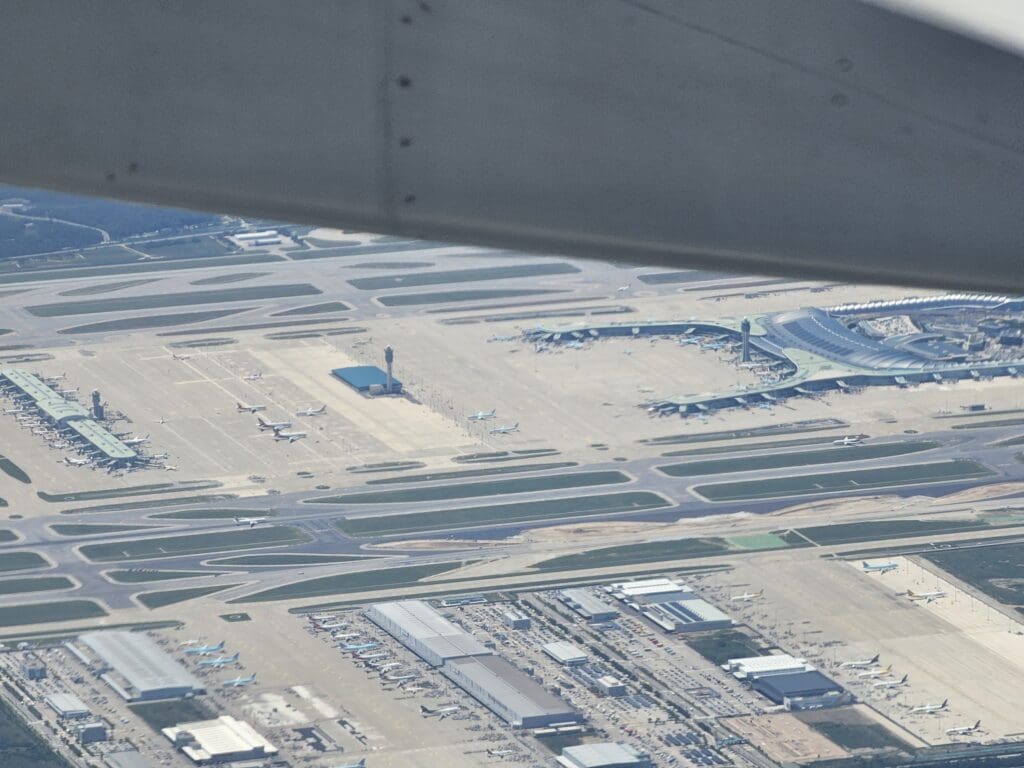
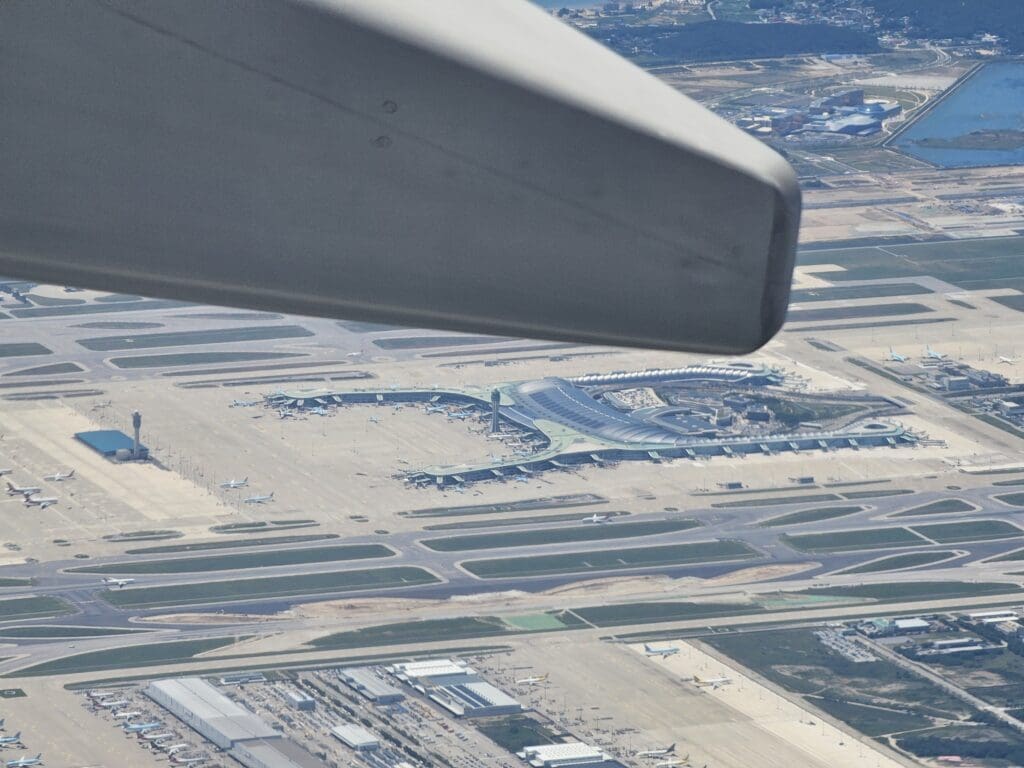
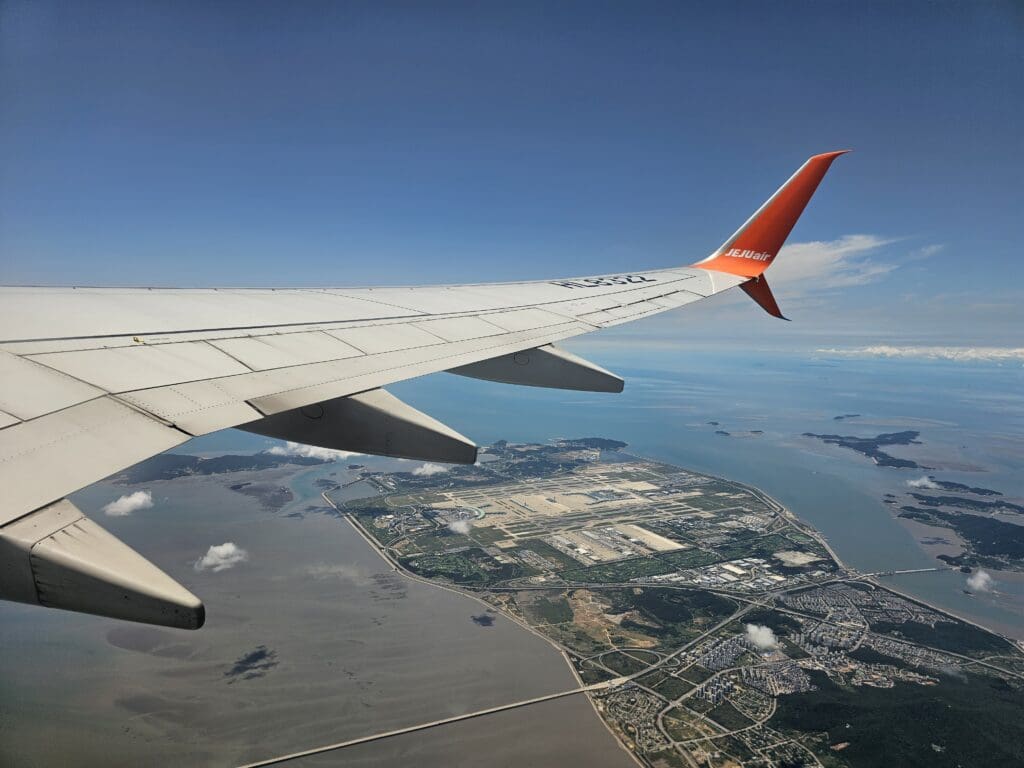
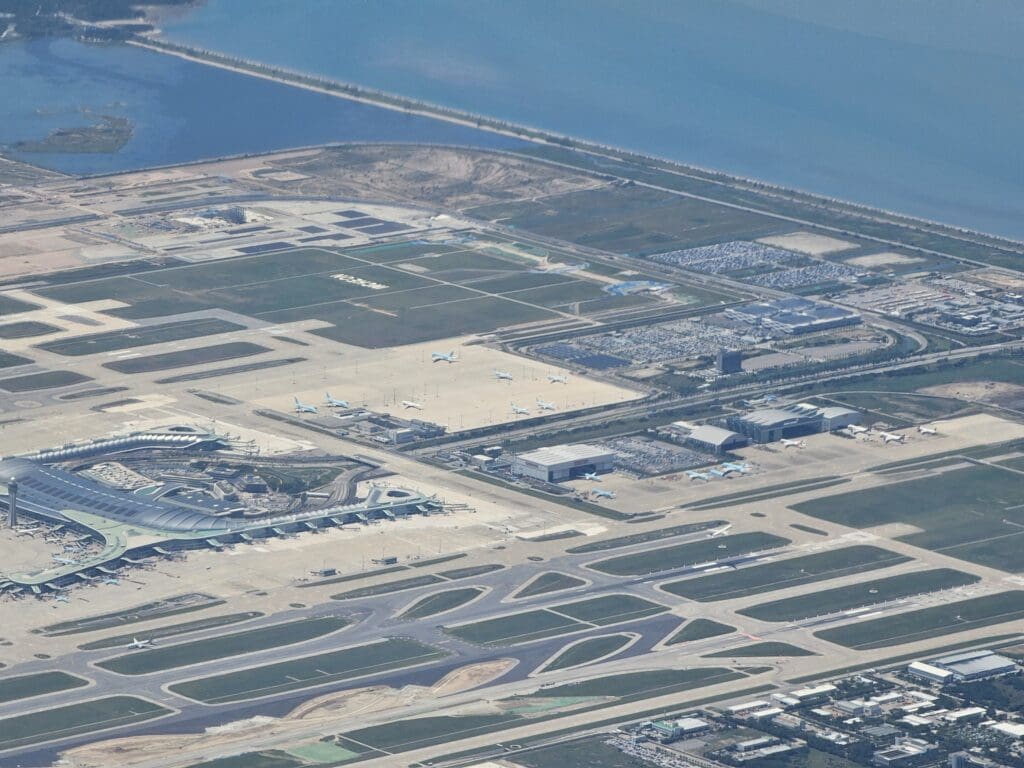
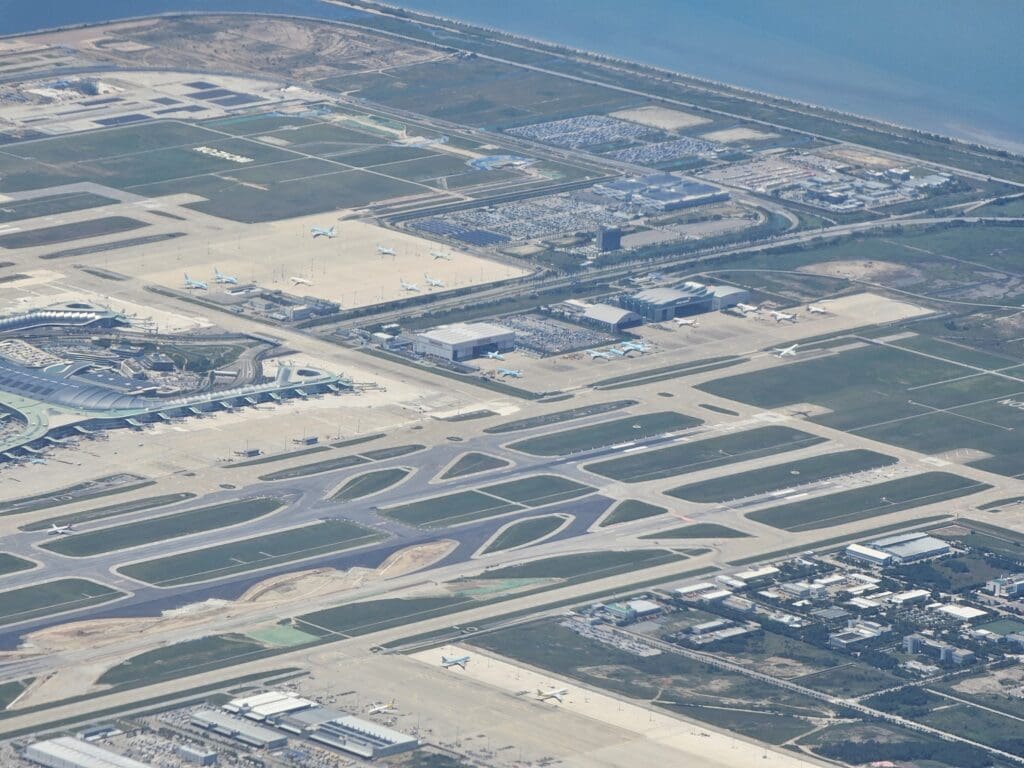
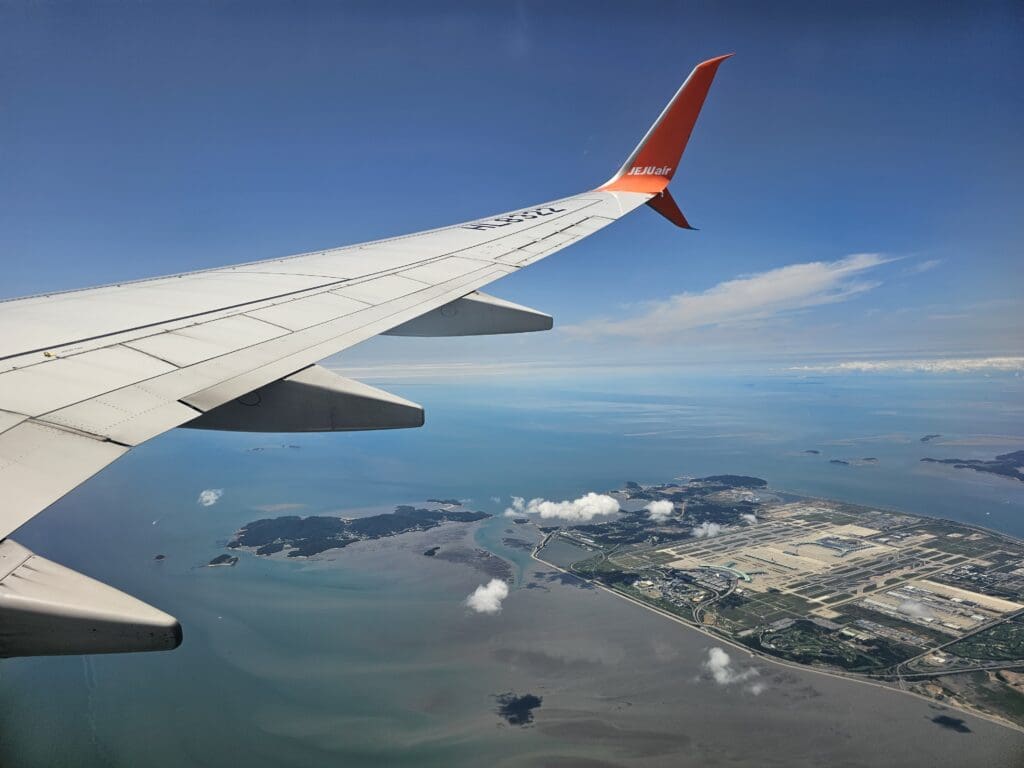
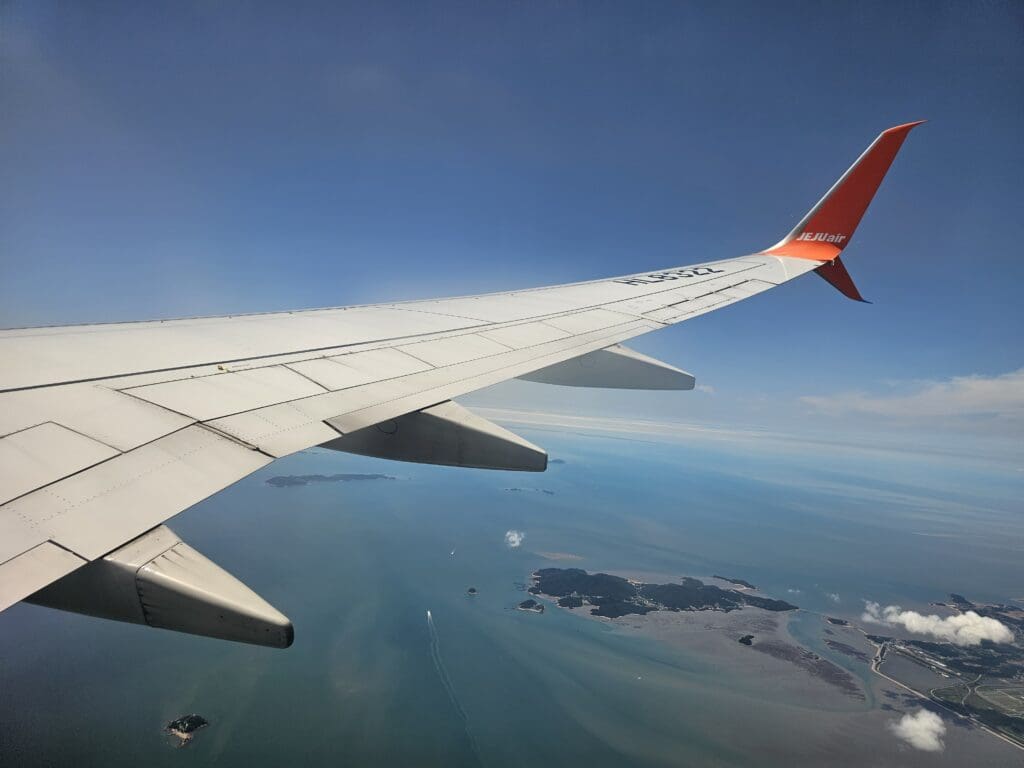
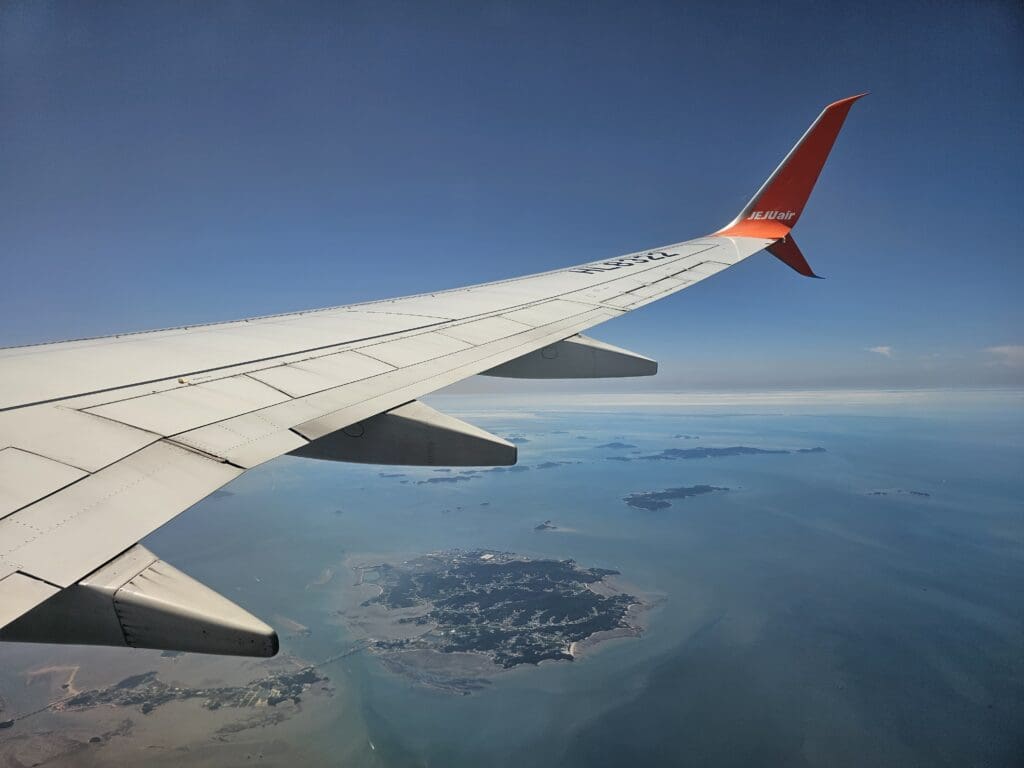
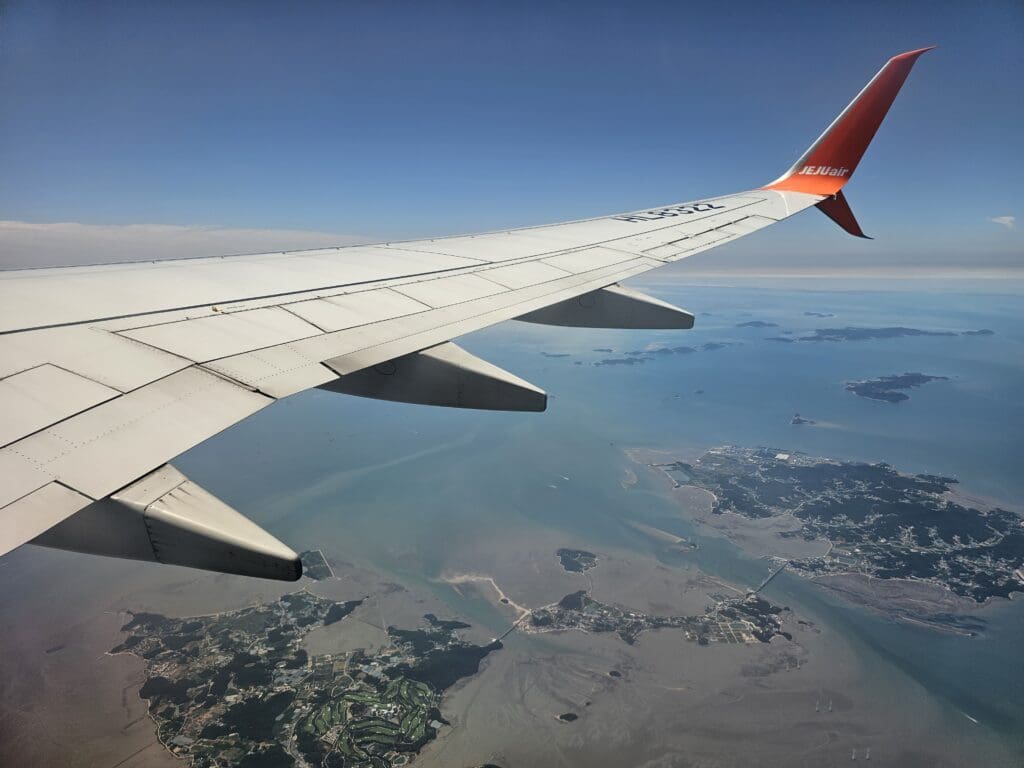
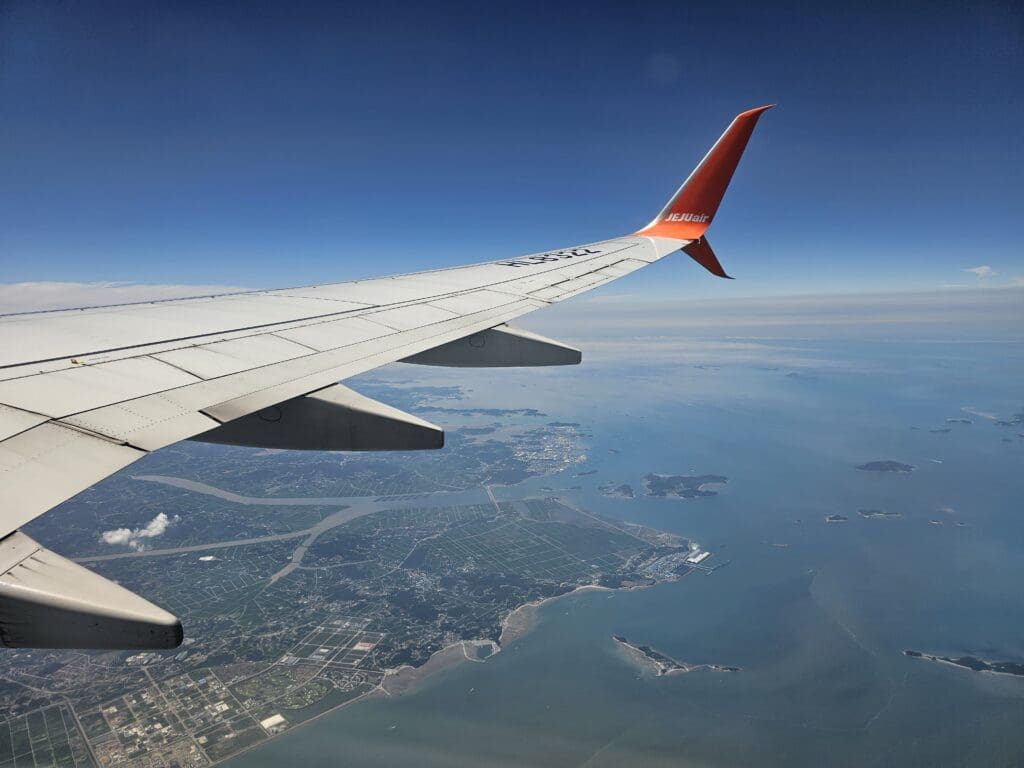
Despite the smooth climb, it wasn’t until the aircraft had levelled off at 20,000 feet that the seatbelt signs were extinguished and a pre-recorded announcement rang out through the cabin in Korean and English with the usual warning regarding seatbelts and a message to passengers advising them to let the crew know if their devices began to feel hot or produce smoke. After this, the Purser performed an announcement in Korean only regarding the soon-to-commence onboard service, and in line with most Korean low-cost short-haul flights, this simply consisted of a member of the crew walking slowly down the aisle holding the menu, with passengers requested to stop them if they wanted to purchase anything from the Air Café. Quickly looking at the Air Café menu, this contained a fairly standard selection of items, the most substantial of which was ramen priced at a standard 5,000 won. I was, however, a little surprised to see that this menu lacked any sort of hot beverage options. As is the case on all Korean low-cost carriers, those flying internationally with Jeju Air can pay to pre-reserve a hot meal, with a total of seventeen on offer, priced between 12,000 won (£6.90) and 20,000 won (£11.50). One of the more interesting items on this menu was the ‘Cabin Crew Meal’ which is advertised as allowing passengers to ‘Try actual in-flight meals that our cabin crew also enjoy!’.
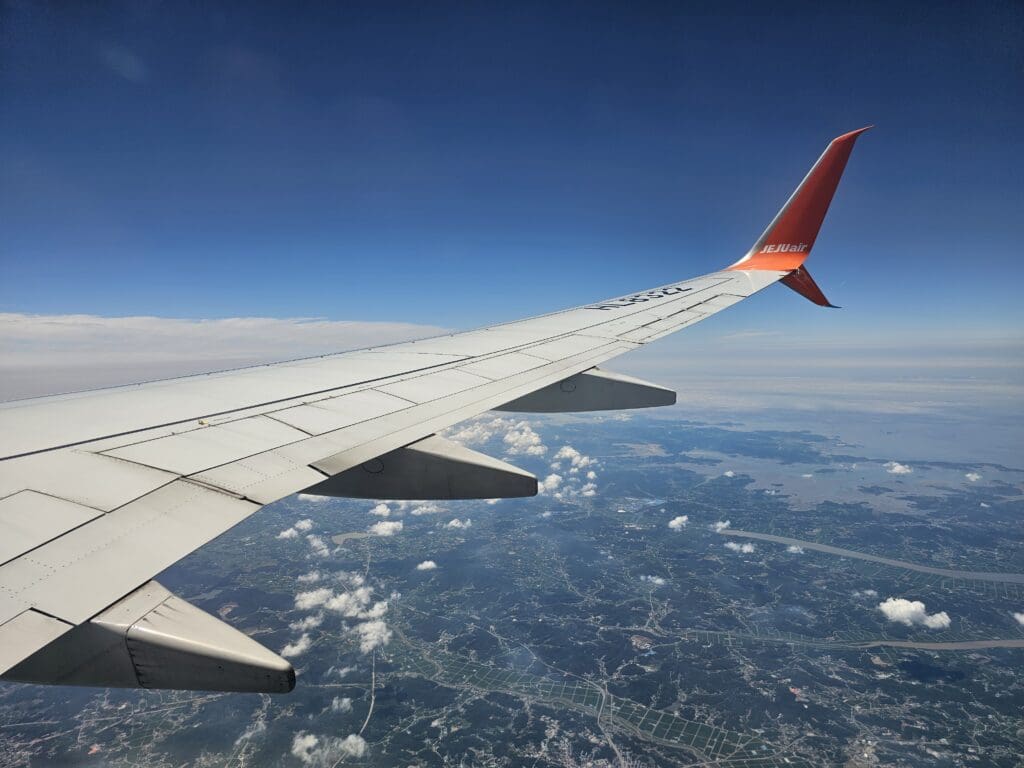
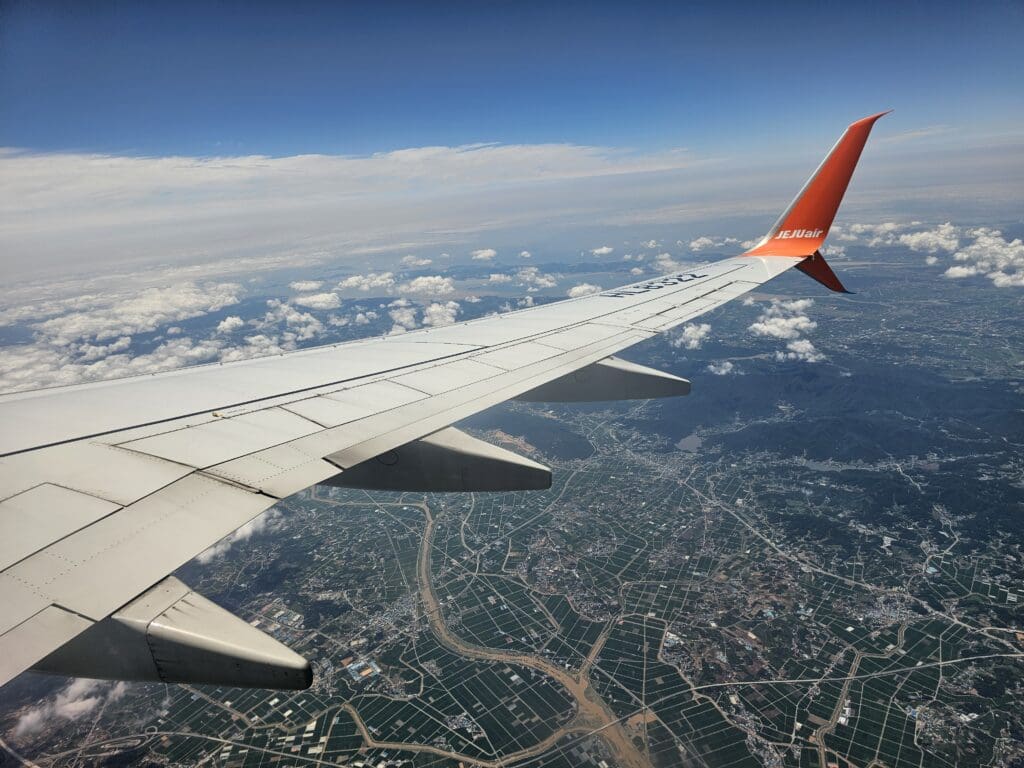
As one of the crew members passed through the cabin, attempting and failing to drum up custom for the inflight service, the Captain’s calm and quiet voice filled the cabin once again. During this announcement, they advised passengers of our expected arrival time of 1330, and provided an update on the weather in Jeju which, as suspected was a far cry from the clear skies of Seoul, featuring strong winds, lashing rains, omnipresent clouds and a temperature of 26 degrees, before thanking passengers for flying with Jeju Air.
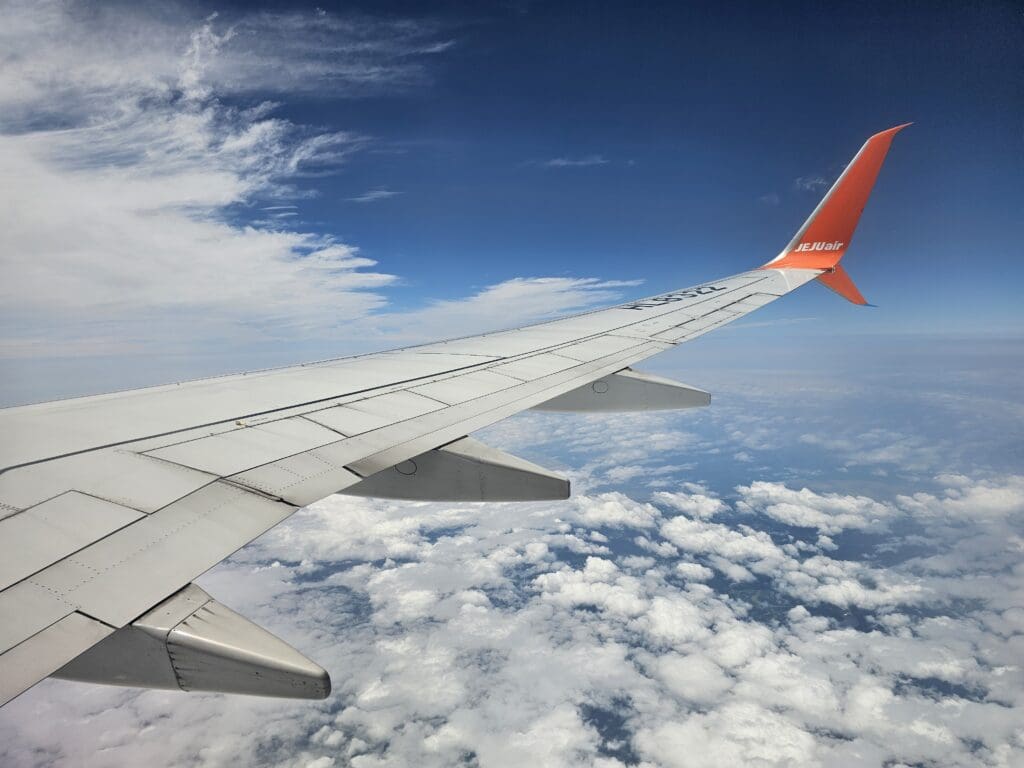
Looking outside, as we neared the border between South Chungcheong and North Jeolla, somewhere near the coastal city of Gunsan, clouds rolled in and stole any views of the Korean Peninsula below. Whilst not greatly required given the short length of the flight, nothing by means of inflight entertainment was provided, with no magazine, no overhead screens or onboard wifi. However, now is probably the time to mention that Jeju Air does hold some special activities to keep passengers entertained on its longer slogs, such as magic shows, card trick performances, balloon animals and tarot card readings!
Examining our route, that day the Boeing seemed to fly a very standard route from Seoul to Jeju. This took us down Korea’s western coastline and whilst the usually low cruising altitudes of flights between the two means that the flight does offer picturesque vistas of rural and coastal Korea, nothing could be seen that lunchtime. Hurtling through the skies of South Jeolla Province, we soon reached the northern fringes of Korea’s sixth-largest city, Gwangju. Once there, after spending just sixteen minutes at our cruising altitude, the Boeing could be felt sinking towards earth, however, the seatbelt signs remained extinguished for a few more minutes.
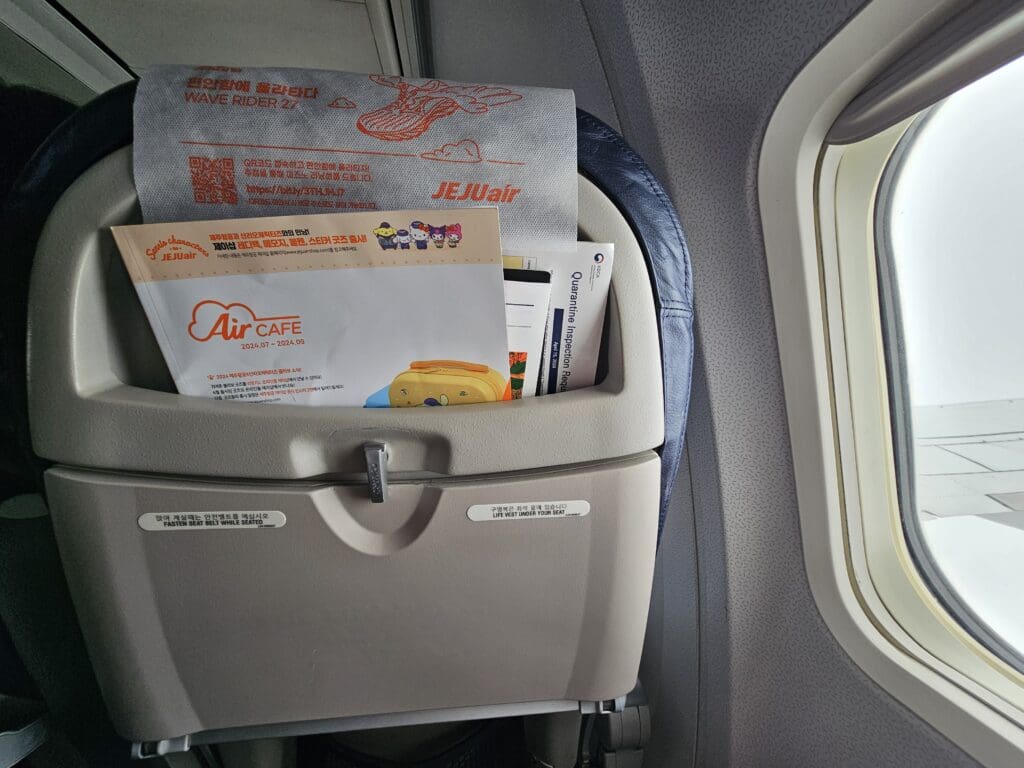
From Gwangju, the aircraft made a beeline for South Jeolla’s southern shores and crossed over Naju, Yeongnam and Haenam before heading out over the sea. Almost immediately upon crossing over the coastline, the seatbelt signs were reilluminated and the usual pre-arrival announcement was made as the crew passed through the cabin ensuring that all was secure and in place for our arrival. A few moments later, the aircraft descended into the clouds and began to be thrown about a little as we descended, with this lasting for a good few minutes.
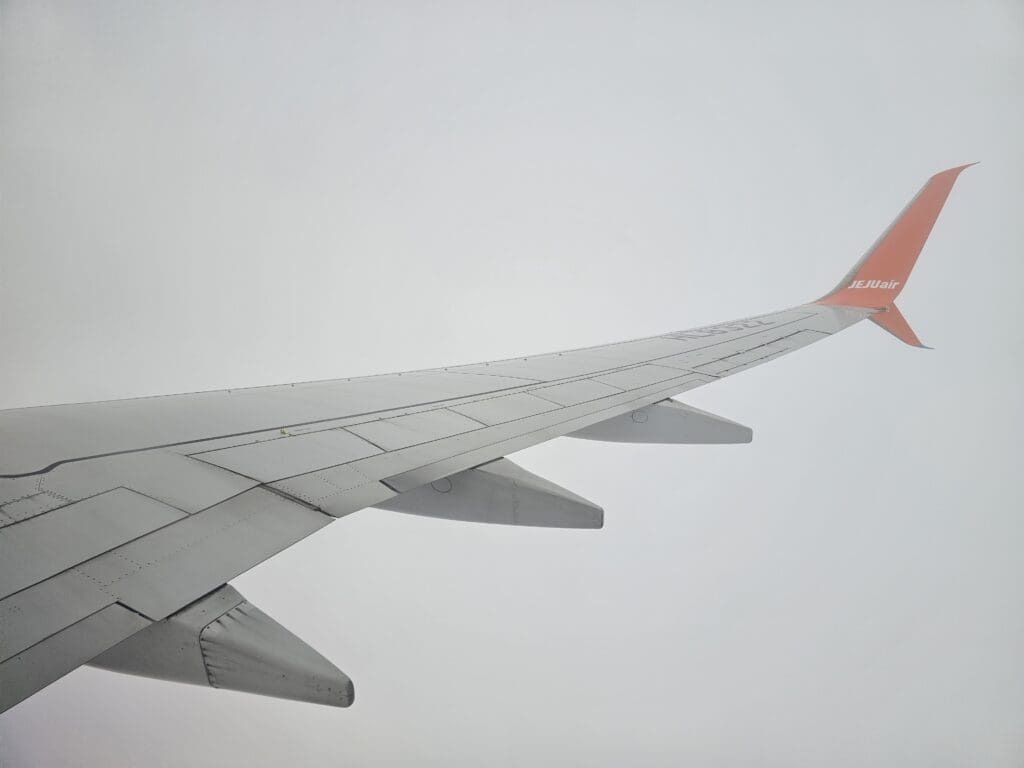
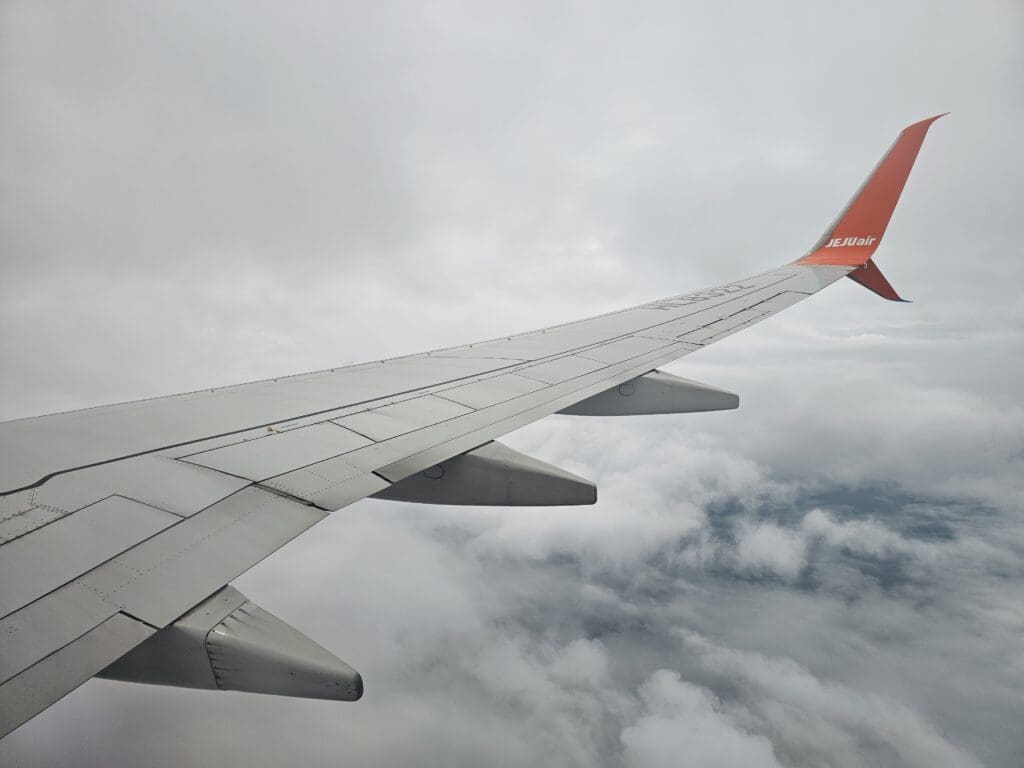
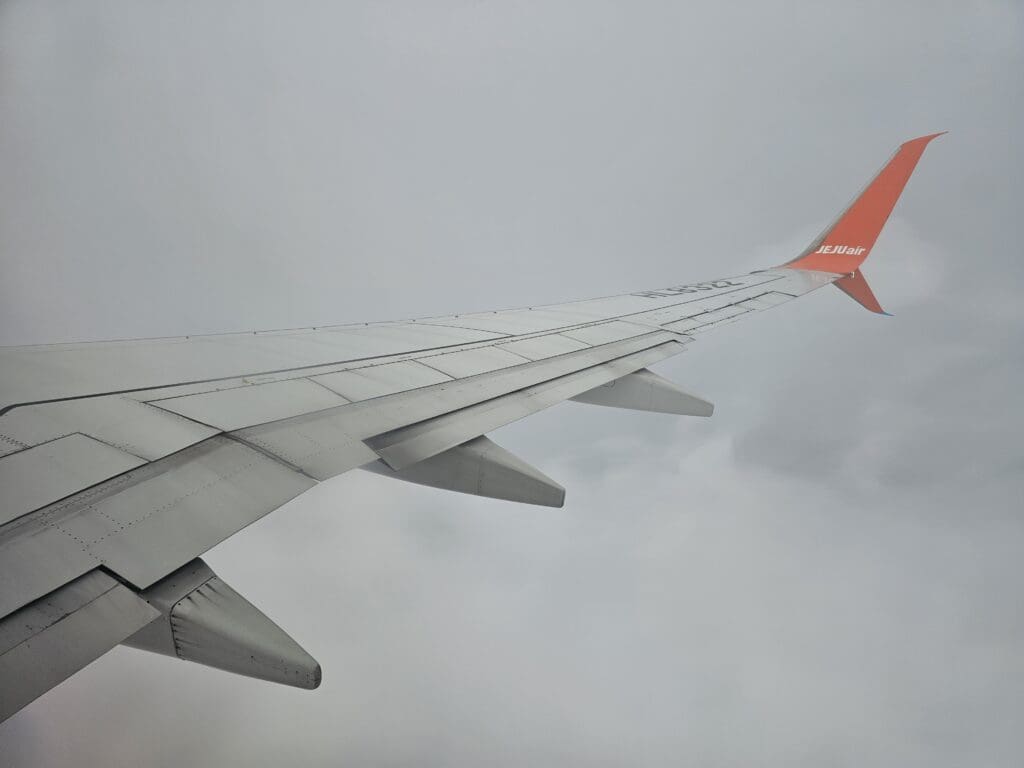
With low-lying clouds around Jeju, whilst still in the clouds, the flaps were extended in preparation for our arrival as we flew down the island’s northern coastline. Whilst this approach can offer wonderful views of Jeju on a clear day (if seated on the left-hand side of the aircraft), it wasn’t until the jet was nearing Jeju City that the seas appeared below. Sitting on the wrong side of the aircraft for any views of Jeju’s rain-soaked capital, nothing could be seen other than the dark waters below and the odd vessel ploughing through these.
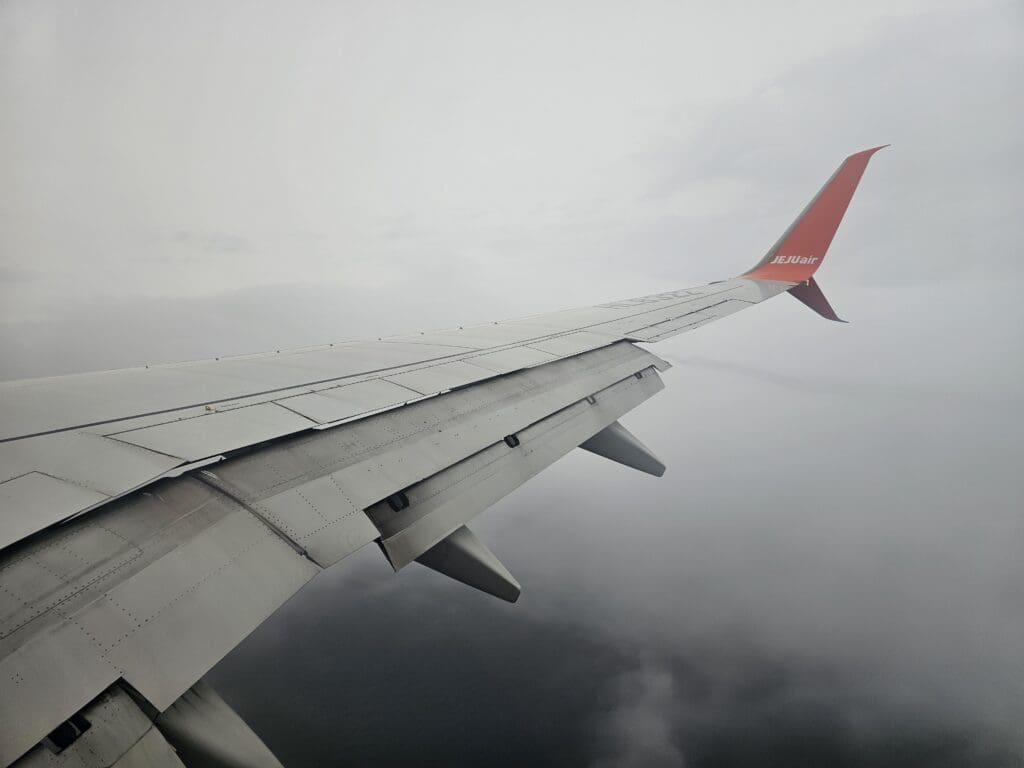
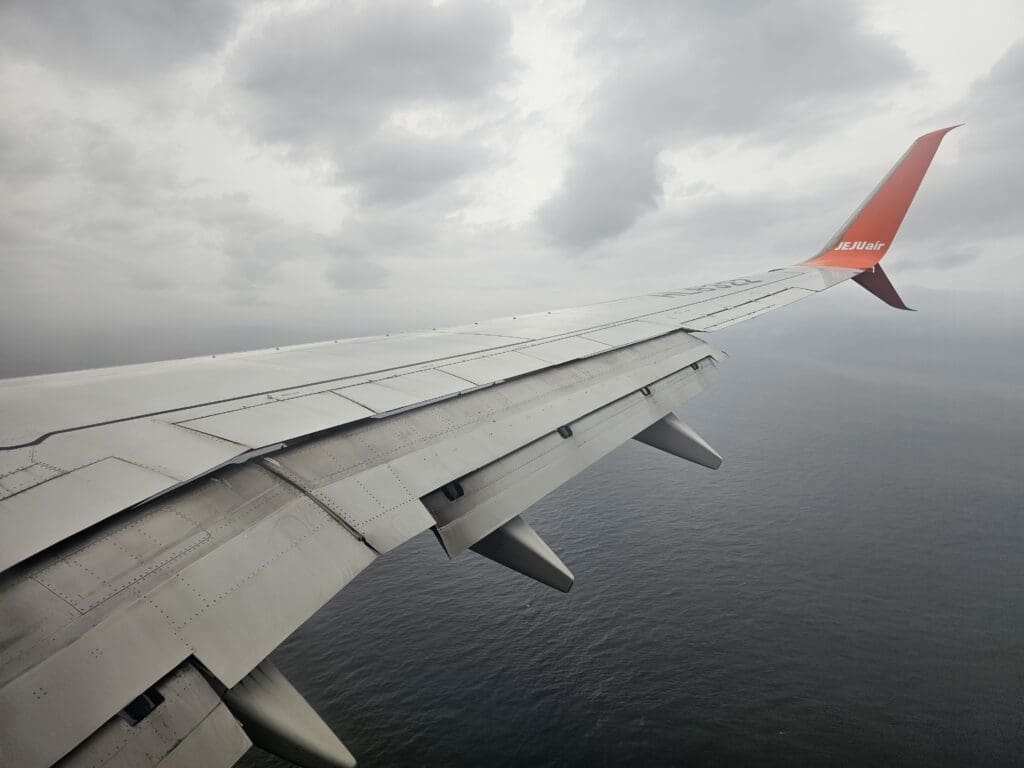
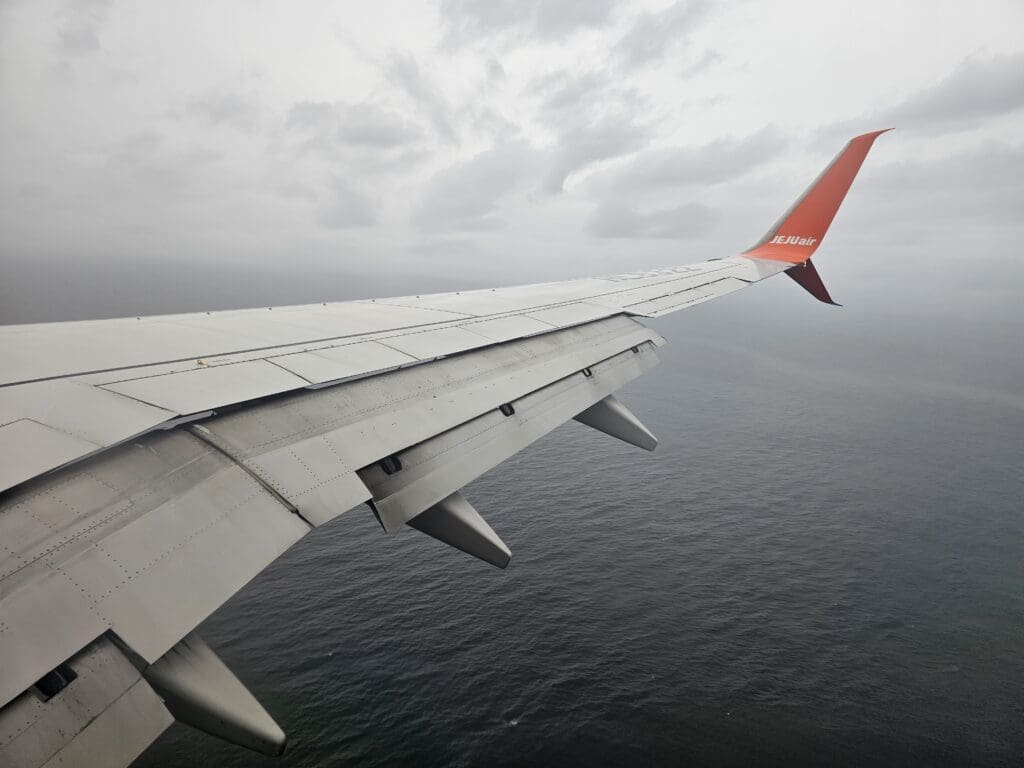
With Jeju International Airport sitting on the coastline, seconds before touching down, the shoreline of Jeju appeared and we crossed over this, passing one of my favourite places to stay before an early morning flight. After this, we crossed over the well-guarded airport perimeter before making a gentle touchdown on Runway 25. Once safely back on the ground, the aircraft engines’ reverse thrust kicked into action and we decelerated with quite some vigour before eventually taxiing off the runway and commencing our short journey to the terminal.
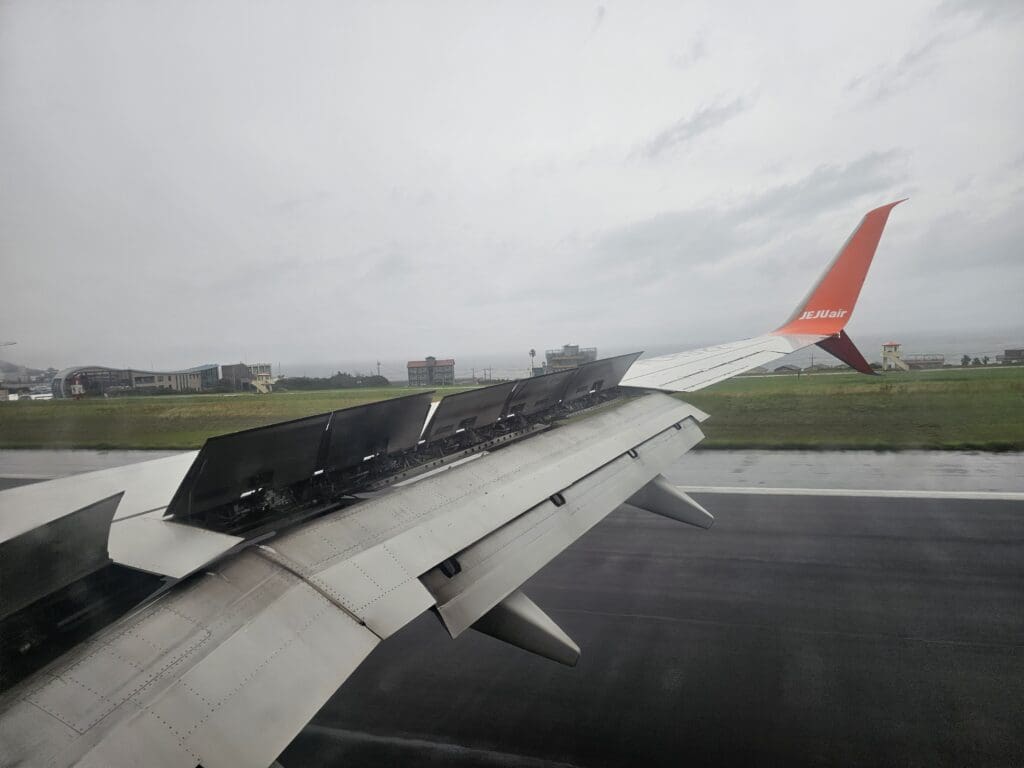
Once off the runway, the Purser performed their post-landing announcement in Korean and English, and a few minutes after touching down, the aircraft turned right into Stand 9 at the terminal building. Much to my delight given the heavy rain, this was a jetbridge stand and thus no bus transfer would be needed to reach the terminal! Thanks to our delayed departure, the aircraft did not come to a halt until 1343, a total of 28 minutes after our scheduled departure time. Once there, the engines spooled down and the cabin jumped up in the usual rush to disembark the aircraft. Fortunately, the jetbridge was soon connected and the queue in the aisle began to budge, at which point, I stood up and made my way out of the aircraft, disembarking the jet around six minutes after we had come to a halt. After thanking the crew members in the forward galley, I stepped out of the aircraft and began the very short walk to the arrivals area, heading down an escalator before steaming through the baggage collection hall and emerging in the busy landside arrivals area no more than a couple of minutes after disembarking the Boeing.
Summary
Ignoring the slight delay, Jeju Air did not leave me with any major complaints, especially considering the price that I had paid for my ticket. Onboard, the aircraft was clean and reasonably comfortable, and the crew were polite and friendly. With that considered, I probably would fly with Jeju Air again.

